Ad
Web application developers_guide_sip_polycom
- 1. Web Application Developer’s Guide for the Polycom® SoundPoint® IP/SoundStation® IP Family SIP 3.1 August, 2008 Edition 1725-17693-310 Rev. A SIP 3.1
- 2. Trademark Information Polycom®, the Polycom logo design, SoundPoint® IP, SoundStation®, SoundStation VTX 1000®, ViaVideo®, ViewStation®, and Vortex® are registered trademarks of Polycom, Inc. Conference Composer™, Global Management System™, ImageShare™, Instructor RP™, iPower™, MGC™, PathNavigator™, People+Content™, PowerCam™, Pro-Motion™, QSX™, ReadiManager™, Siren™, StereoSurround™, V2IU™, Visual Concert™, VS4000™, VSX™, and the industrial design of SoundStation are trademarks of Polycom, Inc. in the United States and various other countries. All other trademarks are the property of their respective owners. Patent Information The accompanying product is protected by one or more U.S. and foreign patents and/or pending patent applications held by Polycom, Inc. © 2008 Polycom, Inc. All rights reserved. Polycom Inc. 4750 Willow Road Pleasanton, CA 94588-2708 USA No part of this document may be reproduced or transmitted in any form or by any means, electronic or mechanical, for any purpose, without the express written permission of Polycom, Inc. Under the law, reproducing includes translating into another language or format. As between the parties, Polycom, Inc. retains title to, and ownership of, all proprietary rights with respect to the software contained within its products. The software is protected by United States copyright laws and international treaty provision. Therefore, you must treat the software like any other copyrighted material (e.g. a book or sound recording). Every effort has been made to ensure that the information in this manual is accurate. Polycom, Inc. is not responsible for printing or clerical errors. Information in this document is subject to change without notice.
- 3. About This Guide The Developer’s Guide for the SoundPoint IP / SoundStation IP family is for developers of applications which use the Web Server and the Microbrowser on SoundPoint IP / SoundStation IP phones. The following related documents for SoundPoint IP / SoundStation IP family are available: • Quick Start Guides, which describe how to assemble the phones • Quick User Guides, which describe the most basic features available on the phones • User Guides, which describe the basic and advanced features available on the phones • Administrator’s Guide, which describes how to configure, customize, manage, and troubleshoot SoundPoint IP / SoundStation IP phone systems • Technical Bulletins, which describe workarounds to existing issues • Release Notes, which describe the new and changed features and fixed problems in the latest version of the software For support or service, please go to Polycom Technical Support at http://www.polycom.com/support/voip/. Polycom recommends that you record the phone model numbers, software (both the bootROM and SIP), and partner platform for future reference. SoundPoint IP / SoundStation IP models: ___________________________ BootROM version: ________________________________________________ SIP Application version: ___________________________________________ Partner Platform: _________________________________________________ iii
- 4. Developer’s Guide SoundPoint IP / SoundStation IP iv
- 5. Contents About This Guide . . . . . . . . . . . . . . . . . . . . . . . . . . . . . . . . . iii 1 Overview . . . . . . . . . . . . . . . . . . . . . . . . . . . . . . . . . . . . . 1–1 What is the Microbrowser . . . . . . . . . . . . . . . . . . . . . . . . . . . . . . . . . . . . . . . 1–1 What is XHTML . . . . . . . . . . . . . . . . . . . . . . . . . . . . . . . . . . . . . . . . . . . . . . . . 1–2 How to Create Applications . . . . . . . . . . . . . . . . . . . . . . . . . . . . . . . . . . . . . . 1–3 New Features in SIP 3.1 . . . . . . . . . . . . . . . . . . . . . . . . . . . . . . . . . . . . . . . . . 1–5 2 Application Development . . . . . . . . . . . . . . . . . . . . . . . . . . 2–1 Supported XHTML Elements . . . . . . . . . . . . . . . . . . . . . . . . . . . . . . . . . . . . . 2–1 Basic Tags . . . . . . . . . . . . . . . . . . . . . . . . . . . . . . . . . . . . . . . . . . . . . . . . . . 2–2 Link Tags . . . . . . . . . . . . . . . . . . . . . . . . . . . . . . . . . . . . . . . . . . . . . . . . . . 2–3 Input Tags . . . . . . . . . . . . . . . . . . . . . . . . . . . . . . . . . . . . . . . . . . . . . . . . . 2–3 Image Tags . . . . . . . . . . . . . . . . . . . . . . . . . . . . . . . . . . . . . . . . . . . . . . . . . 2–6 Table Tags . . . . . . . . . . . . . . . . . . . . . . . . . . . . . . . . . . . . . . . . . . . . . . . . . 2–7 Meta Information Tags . . . . . . . . . . . . . . . . . . . . . . . . . . . . . . . . . . . . . 2–13 SoundPoint IP/SoundStation IP XML API Application Interface . . . . . 2–13 Programmable Soft Keys . . . . . . . . . . . . . . . . . . . . . . . . . . . . . . . . . . . . 2–14 Telephone Integration URIs . . . . . . . . . . . . . . . . . . . . . . . . . . . . . . . . . 2–16 Push Requests . . . . . . . . . . . . . . . . . . . . . . . . . . . . . . . . . . . . . . . . . . . . . 2–19 Telephony Notification Events . . . . . . . . . . . . . . . . . . . . . . . . . . . . . . . 2–22 Phone State Polling . . . . . . . . . . . . . . . . . . . . . . . . . . . . . . . . . . . . . . . . . 2–27 API Security . . . . . . . . . . . . . . . . . . . . . . . . . . . . . . . . . . . . . . . . . . . . . . . 2–32 HTTP Support . . . . . . . . . . . . . . . . . . . . . . . . . . . . . . . . . . . . . . . . . . . . . . . . 2–33 Microbrowser User Interface . . . . . . . . . . . . . . . . . . . . . . . . . . . . . . . . . . . . 2–33 Launching the Microbrowser . . . . . . . . . . . . . . . . . . . . . . . . . . . . . . . . 2–34 Navigation and Form Editing . . . . . . . . . . . . . . . . . . . . . . . . . . . . . . . . 2–35 Idle Display Microbrowser . . . . . . . . . . . . . . . . . . . . . . . . . . . . . . . . . . 2–35 Developing an XHTML Application . . . . . . . . . . . . . . . . . . . . . . . . . . . . . . 2–36 Changing Configuration Parameters . . . . . . . . . . . . . . . . . . . . . . . . . . 2–36 Sample Applications . . . . . . . . . . . . . . . . . . . . . . . . . . . . . . . . . . . . . . . 2–38 v
- 6. Developer’s Guide SoundPoint IP / SoundStation IP 3 Troubleshooting . . . . . . . . . . . . . . . . . . . . . . . . . . . . . . . . 3–1 XML Errors . . . . . . . . . . . . . . . . . . . . . . . . . . . . . . . . . . . . . . . . . . . . . . . . . . . . 3–1 A Appendix . . . . . . . . . . . . . . . . . . . . . . . . . . . . . . . . . . . . .A–1 Unsupported XHTML Elements . . . . . . . . . . . . . . . . . . . . . . . . . . . . . . . . . A–1 Index . . . . . . . . . . . . . . . . . . . . . . . . . . . . . . . . . . . . .Index–1 vi
- 7. 1 Overview This chapter provides an overview of the Web Server and the Microbrowser available on SoundPoint IP 330/320, 430, 501, 550, 560, 600, 601, 650, and 670 desktop phones and SoundStation IP 4000, 6000, and 7000 conference phones. It also provides an introduction to XHTML and guidelines for the application development. This chapter contains information on: • What is the Microbrowser • What is XHTML • How to Create Applications • New Features in SIP 3.1 To develop an application that can run on the Web Server and the Microbrowser, refer to Application Development on page 2-1. To troubleshoot any problems with your applications, refer to Troubleshooting on page 3-1. What is the Microbrowser The Microbrowser is like any Web browser—Microsoft Internet Explorer and Firefox, for example—but supports only a subset of XHTML features. It can connect to Web servers hosted in the Internet or intranet and download XHTML pages. The Microbrowser supports a limited number of XHTML 1.0 features—it does not have full Web browser functionality. The Microbrowser downloads XHTML content from a Web server into the phone’s memory, then parses the content to identify XHTML tags and renders these tags onto the phone’s graphic display. The appearance of the rendered page depends on the graphical capabilities and display size of the device on which the browser is running. Complicated pages should be avoided on devices with very small displays. The Microbrowser does not support scripting (such as JavaScript). All actions on data entered into forms is processed by the server using POST or GET methods. 1-1
- 8. Developer’s Guide SoundPoint IP / SoundStation IP The XHTML pages displayed on the Microbrowser can contain static or dynamic information. Static XHTML. These pages are created using XHTML editors and hosted by the Web server. These pages are accessed from the Microbrowser (using HTTP protocol) by entering the URL to access the page. These XHTML pages are called static, because the information that is displayed is already coded into the XHTML pages. These pages do not include information that keep changing or contact other services for update. Dynamic XHTML. These pages involves dynamic information updates of XHTML pages by an application hosted on the Web server. The application residing on the Web server will get information from an intranet or through the Internet—data service providers like Yahoo, Exchange Server, Call Control Servers and other enterprise servers. Users can launch the Microbrowser on a SoundPoint IP or SoundStation IP phone by pressing the Applications key, or if there isn’t one on the phone, it can be accessed through the Menu key by selecting Applications. Note As of SIP 2.2, the Services key and menu entry were renamed Applications, however the functionality remains the same. The Microbrowser is supported on: • SoundPoint IP 330/320 — screen resolution - 102*22 pixels (3” by 1”) • SoundPoint IP 430 — screen resolution – 132*46 pixels (3.5”*1.5”) • SoundPoint IP 501 — screen resolution – 160*80 pixels (4” by 2”) • SoundPoint IP 550/560/601/650 — screen resolution – 320*160 pixels (4” by 2”) • SoundPoint IP 670 — screen resolution – 320*160 pixels (4” by 2”) • SoundStation IP 4000/6000 — screen resolution – 240*68 pixels (2.4” by 0.8”) • SoundStation IP 7000 — screen resolution – 255*128 pixels (3” by 1.5”) What is XHTML XHTML is the abbreviation of eXtensible HyperText Markup Language. XHTML 1.0 is a transformation of HTML 4.01 into valid XML. The use of the stricter XML syntax makes parsing of XHTML much easier for small clients, but XHTML 1.0 was also the first step towards making HTML easily extensible. Moving to XML allowed the methods used to create XML extensions to apply to HTML as well. Step two occurred with XHTML 1.1, where XHTML was divided up into ‘modules’, where any features above and 1-2
- 9. Overview beyond a skeleton set were grouped into individual modules. User agent (UA) developers could then decide which extensions to support. A simple user agent can be considered a fully compliant user agent by supporting only the Basic module, whereas a more powerful browser can support all the official modules, as well as those developed by third parties. Modularization is also intended to help content creators. As more and more devices become web-enabled, the number of platforms a content creator will be asked to support will become unreasonable. By dividing HTML up into different ‘building blocks’ content creators can supply a minimal version of their site for user agents that only support the Basic module, a moderate version of their site for user agents who support the additional modules, and a full version of their site for user agents that support the full range of the XHTML specification. Finally the X in XHTML was intended to help people who wish to extend HTML. The use of XML brought a standard grammar with which they could define their extension, and the modularization meant that their extension would be just another module that a user agent developer or content creator could choose to support. Additionally, since XHTML pages should state what modules are required to accurately render them, the user agent software could dynamically load a ‘plug-in’ that it could use to render a module that was defined after the user agent had been originally released. For more information, go to: • HTML 4.0—http://www.w3.org/TR/1999/REC-html401-19991224 • XHTML™ 1.0—http://www.w3.org/TR/2002/REC-xhtml1-20020801 • XHTML™ Basic—http://www.w3.org/TR/2000/REC-xhtml-basic-20001219/ • XHTML™ 1.1—http://www.w3.org/TR/2001/REC-xhtml11-20010531/ • XHTML Tables Module - XHTML™2.0—http://www.w3.org/TR/2004/WD-xhtml2-20040722/m od-tables.html For the purposes of this guide, it is assumed that you have experience in HTML and XHTML programming or access to someone who has such experience. How to Create Applications You can design the following examples of applications: • Web browser 1-3
- 10. Developer’s Guide SoundPoint IP / SoundStation IP • Company directory • Stock ticker Depending on the type and complexity of the application, you might use one of the following tools for creation: • Text editor • XML editor • Microsoft Word When designing applications, you might want to consider the following guidelines: Note These guidelines are for your information only. You are solely responsible for determining the suitability and applicability of this information to your needs. 1. Spend sufficient time designing the application by: — Developing a conceptual design — Describe all user-application interactions — Plan for all user types 2. Create standardized applications to assist in: — Lowering design time — Speed up debugging — Increasing usability 3. Promote consistent output and predictable user input. 4. Create a prototype application to test on sample users. 5. Thoroughly test your application before releasing to: — Identify all user interface issues — Verify that all error conditions are caught cleanly For step-by-step instructions on how to develop an XHTML application that can be run on the Microbrowser of all SoundPoint IP and SoundStation IP phones, refer to Application Development on page 2-1. Note Polycom is not responsible for troubleshooting any programming that you create for the Microbrowser. 1-4
- 11. Overview New Features in SIP 3.1 The following new features were introduced in SIP 3.1: • SoundPoint IP/SoundStation IP XML API Application Interface—Expanded support in the Microbrowser for applications on the SoundPoint IP 320/330, 430, 501, 550, 560, 650, and 670 desktop phones, and SoundStation IP 4000, 6000, and 7000 conference phones. The SoundPoint IP/SoundStation IP XML API is intended to provide developers with flexibility in developing applications on SoundPoint IP and SoundStation IP phones, while tightly integrating into the phone’s telephony capabilities and functions. 1-5
- 12. Developer’s Guide SoundPoint IP / SoundStation IP 1-6
- 13. 2 Application Development This chapter presents step-by-step instructions on how to develop an XHTML application that can be run on the Web Server and Microbrowser of certain SoundPoint IP and SoundStation IP phones. It also describes the configuration parameters that can be found in the sip.cfg configuration file. This chapter contains information on: • Supported XHTML Elements • SoundPoint IP/SoundStation IP XML API Application Interface • HTTP Support • Microbrowser User Interface • Developing an XHTML Application To troubleshoot any problems with your applications, refer to Troubleshooting on page 3-1. Note Polycom is not responsible for troubleshooting any programming that you create for the Microbrowser. Supported XHTML Elements The Microbrowser supports a subset of XHTML elements. Most are derived from HTML 4.01. The supported elements and attributes are: • Basic Tags • Link Tags • Input Tags • Image Tags • Table Tags 2-1
- 14. Developer’s Guide SoundPoint IP / SoundStation IP • Meta Information Tags Unsupported elements and attributes are described in Unsupported XHTML Elements on page A-1. Basic Tags The following basic tags are supported: • <!DOCTYPE>—Defines the document type • <!--...-->—Defines a comment <!DOCTYPE> The <!DOCTYPE> declaration is the very first thing in your document, before the <html> tag. This tag tells the browser which XHTML specification the document uses. XHTML 1.0 specifies three XML document types: Strict, Transitional, and Frameset. • XHTML Strict — Use this DTD when you want clean markup, free of presentational clutter. For example, <!DOCTYPE html PUBLIC "-//W3C//DTD XHTML 1.0 Strict//EN" "http://www.w3.org/TR/xhtml1/DTD/xhtml1-strict.dtd"> • XHTML Transitional — Use this DTD when you need to use XHTML's presentational features. For example, <!DOCTYPE html PUBLIC "-//W3C//DTD XHTML 1.0 Transitional//EN" "http://www.w3.org/TR/xhtml1/DTD/xhtml1-transitional.dtd"> • XHTML Frameset — Use this DTD when you want to use frames. For example, <!DOCTYPE html PUBLIC "-//W3C//DTD XHTML 1.0 Frameset//EN" "http://www.w3.org/TR/xhtml1/DTD/xhtml1-frameset.dtd"> XHTML 1.1 specifies one XML document type: Strict. For example, <!DOCTYPE html PUBLIC "-//W3C//DTD XHTML 1.1//EN" "http://www.w3.org/TR/xhtml11/DTD/xhtml11.dtd"> This tag does not have any attributes. 2-2
- 15. Application Development <!--...--> The comment tag is used to insert a comment in the source code. A comment will be ignored by the browser. You can use comments to explain your code, which can help you when you edit the source code at a later date. This tag does not have any attributes. Link Tags The following link tag is supported: • <a>—Defines an anchor Note The Microbrowser supports both http:// and tel:// URL schemes as well as internal URIs. When a tel:// URL is selected, the phone switches to the telephony application and dials the number specified in the URL. Currently the number is dialed as-is, however, full support for tel:// URL parsing as specified in RFC 2806 will be available in a future release. sip:// URLs are not supported at this time. <a> The <a> tag defines an anchor. An anchor can be used to create a link to another document by using the href attribute. The following attributes are supported: Attribute Value/s Description href URL (Ex:” www.polycom.com”) The target URL of the link name section_name Names an anchor. Use this attribute to create a bookmark in a document. In future versions of XHTML the name attribute will be replaced by the id attribute. Note: This attribute is parsed, but not used. Input Tags The following input tags are supported: • <form>—Defines a form • <input>—Defines an input field 2-3
- 16. Developer’s Guide SoundPoint IP / SoundStation IP Note The Microbrowser supports both the GET and POST methods for submitting forms. Nesting forms within tables is supported. However, nesting of one form tag within another is not supported and may lead to unexpected results. <form> The form element creates a form for user input. A form can contain text fields, check boxes, radio buttons and more. Forms are used to pass user data to a specified URL. The following attributes are supported: Attribute Value/s Description action URL A URL that defines where to send Ex: http://www.google.com the data when the submit button is pushed method get The HTTP method for sending post data to the action URL. Default is get. method="get": This method sends the form contents in the URL: URL?name=value&name=value. Note: If the form values contains non-ASCII characters or exceeds 100 characters you MUST use method="post". method="post": This method sends the form contents in the body of the request. name form_name Defines a unique name for the form 2-4
- 17. Application Development <input> The <input> tag defines the start of an input field where the user can enter data. In XHTML the <input> tag must be properly closed. The following attributes are supported: Attribute Value/s Description checked checked Indicates that the input element should be checked when it first loads. Note: Used with type="checkbox" and type="radio" name field_name Defines a unique name for the input element. Note: This attribute is required with type="button", type="checkbox", type="file", type="hidden", type="image", type="password", type="text", and type="radio" type checkbox Indicates the type of the input hidden element. The default value is password "text". radio reset submit text value value For buttons, reset buttons and submit buttons: Defines the text on the button. For image buttons: Defines the symbolic result of the field passed to a script. For checkboxes and radio buttons: Defines the result of the input element when clicked. The result is sent to the form's action URL. For hidden, password, and text fields: Defines the default value of the element. Note: Cannot be used with type="file" Note: This attribute is required with type="checkbox" and type="radio" 2-5
- 18. Developer’s Guide SoundPoint IP / SoundStation IP Image Tags The following image tag is supported: • <img>—Defines an image The Microbrowser supports images stored in uncompressed .bmp format. While all BMP bit depths will be displayed to the best of the phone’s ability, it is recommended that the image format most suitable for the target platform be chosen. For example: • The SoundPoint IP 601 LCD supports four levels of grey, so a 16-color BMP format would be most appropriate. • The SoundPoint IP 670 LCD supports 12-bit color. Images can be scrolled up and down, however images that are too wide will be truncated. Various platforms have differing limits due to memory. There are also differing pixel limits for devices of differing pixel depth. A 1 bit per pixel image 160x80 requires only 1600 bytes. For a 24 bit picture, the memory requirement is 38400 bytes. There are several limits depending on the source data (this involves the cache limits in configuration) and the display converted data, which is dependant on available RAM (and is limited in the code depending on platform). <img> The img element defines an image. Note The "align", "border", "hspace", and "vspace" attributes of the image element are not supported in XHTML 1.0 Strict DTD. The following attributes are supported: Attribute Value/s Description src URL The URL of the image to display (Ex: “http://www.topxml.com/images/to pxml_site.gif” or ”c:imagesimg1.jpg” ) height Pixels (number, EX: “30” ) Specifies the height of the image % in pixel or percent. width Pixels (number, EX: “30” ) Specifies the width of the image in % pixel or percent. 2-6
- 19. Application Development Table Tags The following table tags are supported: • <table>—Defines a table • <caption>—Defines a table caption • <th>—Defines a table header • <tr>—Defines a table row • <td>—Defines a table cell • <thead>—Defines a table header • <tbody>—Defines a table body • <tfoot>—Defines a table footer Note XHTML tables must be properly formatted (should include <tbody> and </tbody> tags). <table> The <table> tag defines a table. Inside a <table> tag you can put table headers, table rows, table cells, and other tables. The following attributes are supported: Attribute Value/s Description align Left Aligns the table. Deprecated. Use center styles instead. right border Pixels (number, EX: “30” ) Specifies the border width. Tip: Set border="0" to display tables with no borders! cellpaddin Pixels (number, EX: “30” ) Specifies the space between the g % cell walls and contents cellspacin Pixels (number, EX: “30” ) Specifies the space between cells. g % width % Specifies the width of the table Pixels (number, EX: “30” ) 2-7
- 20. Developer’s Guide SoundPoint IP / SoundStation IP <caption> This element defines a table caption. The <caption> tag must be inserted immediately after the <table> tag. You can specify only one caption per table. Usually the caption will be centered above the table. The “align” attribute of the caption element is not supported in XHTML 1.0 Strict DTD. The following attributes are supported: Attribute Value/s Description MB Support align Left How to align the caption. Need to verify right Deprecated. Use styles instead. top bottom id unique_name Defines a unique name for the map Need to verify tag. class class_rule The class of the element Need to verify style_rule title tooltip_text A text to display in a tool tip Need to verify style style_definition An inline style definition Need to verify dir ltr (left to right) Sets the text direction Need to verify rtl (left to right) lang language_code (Ex: EN, Sets the language code Need to verify deu/ger, hin) xml:lang language_code (Ex: EN, Sets the language code Need to verify deu/ger, hin) <th> This tag defines a table header cell in a table. The text within the th element usually renders in bold. The “bgcolor”, “height”, “width”, and “nowrap” attributes of the th element are not supported in XHTML 1.0 Strict DTD. The following attributes are supported: Attribute Value/s Description abbr abbr_text Specifies an abbreviated version of the content in a cell align left Specifies the horizontal alignment right of cell content center justify char axis category_names Defines a name for a cell 2-8
- 21. Application Development Attribute Value/s Description bgcolor rgb(x,x,x) Specifies the background color of #xxxxxx the table cell. Deprecated. Use colorname styles instead. char character Specifies which character to align text on. Note: Only used if align="char"! charoff Pixels (number, EX: “30” ) Specifies the alignment offset to % the first character to align on. Note: Only used if align="char"! colspan number Indicates the number of columns this cell should span. headers header_cells'_id A space-separated list of cell IDs that supply header information for the cell. This attribute allows text-only browsers to render the header information for a given cell. height Pixels (number, EX: “30” ) Specifies the height of the table cell. Deprecated. Use styles instead. nowrap nowrap Whether to disable or enable automatic text wrapping in this cell. Deprecated. Use styles instead. rowspan number Indicates the number of rows this cell should span. scope col Specifies if this cell provides colgroup header information for the rest of row the row that contains it (row), or for rowgroup the rest of the column (col), or for the rest of the row group that contains it (rowgroup), or for the rest of the column group that contains it valign top Specifies the vertical alignment of middle cell content bottom baseline width Pixels (number, EX: “30” ) Specifies the width of the table % cell. Deprecated. Use styles instead. id unique_name Defines a unique name for the map tag. 2-9
- 22. Developer’s Guide SoundPoint IP / SoundStation IP Attribute Value/s Description class class_rule The class of the element style_rule title tooltip_text A text to display in a tool tip style style_definition An inline style definition dir ltr (left to right) Sets the text direction rtl (left to right) lang language_code (Ex: EN, deu/ger, Sets the language code hin) xml:lang language_code (Ex: EN, deu/ger, Sets the language code hin) <tr> This tag defines a row in a table. The following attributes are supported: Attribute Value/s Description align right Defines the text alignment in cells. left center justify char <td> This tag defines a cell in a table. The following attributes are supported: Attribute Value/s Description align left Specifies the horizontal alignment right of cell content center justify char colspan number Indicates the number of columns this cell should span. rowspan number Indicates the number of rows this cell should span. 2 - 10
- 23. Application Development <thead> This tag defines a table header. The thead, tfoot and tbody elements enable you to group rows in a table. When you create a table, you might want to have a header row, some rows with data, and a row with totals at bottom. This division enables browsers to support scrolling of table bodies independently of the table header and footer. When long tables are printed, the table header and footer information may be repeated on each page that contains table data. Note The <thead> must have a <tr> tag inside. If you use the thead, tfoot and tbody elements, you must use every element. They should appear in this order: <thead>, <tfoot> and <tbody>, so that browsers can render the foot before receiving all the data. You must use these tags within the table element. The following attributes are supported: Attribute Value/s Description align right Defines the text alignment in cells. left center justify char char. character Specifies which character to align text on Note: Only used if align="char"! charoff Pixels (number, EX: “30” ) Specifies the alignment offset to % the first character to align on. Note: Only used if align="char"! valign top Specifies the vertical text middle alignment in cells bottom baseline id unique_name Defines a unique name for the map tag. class class_rule The class of the element style_rule title tooltip_text A text to display in a tool tip style style_definition An inline style definition 2 - 11
- 24. Developer’s Guide SoundPoint IP / SoundStation IP Attribute Value/s Description dir ltr (left to right) Sets the text direction rtl (left to right) lang language_code (Ex: EN, deu/ger, Sets the language code hin) xml:lang language_code (Ex: EN, deu/ger, Sets the language code hin) <tbody> This tag defines a table body. The thead, tfoot and tbody elements enable you to group rows in a table. The following attributes are supported: Attribute Value/s Description align right Defines the text alignment in cells. left center <tfoot> This tag defines a table footer. The thead, tfoot and tbody elements enable you to group rows in a table. The following attributes are supported: Attribute Value/s Description align right Defines the text alignment in cells. left center justify char char. character Specifies which character to align text on Note: Only used if align="char"! charoff Pixels (number, EX: “30” ) Specifies the alignment offset to % the first character to align on. Note: Only used if align="char"! valign top Specifies the vertical text middle alignment in cells bottom baseline 2 - 12
- 25. Application Development Attribute Value/s Description id unique_name Defines a unique name for the map tag. class class_rule The class of the element style_rule title tooltip_text A text to display in a tool tip style style_definition An inline style definition dir ltr (left to right) Sets the text direction rtl (left to right) lang language_code (Ex: EN, deu/ger, Sets the language code hin) xml:lang language_code (Ex: EN, deu/ger, Sets the language code hin) Meta Information Tags The following meta information tags are supported: • <head>—Defines information about the document Note Due to space constraints, there isn’t a static title bar at the top of the Microbrowser window, as there is in most other browsers. The title is displayed in large bold text in the first line of the page, and is scrolled off the screen as the focus is moved down the page. <head> The head element can contain information about the document. The browser does not display the “head information” to the user. The following tag can be in the head section: <title>. No attributes are supported. SoundPoint IP/SoundStation IP XML API Application Interface In SIP 3.1, there is expanded support in the Microbrowser for applications on the SoundPoint IP 320/330, 430, 501, 550, 560, 650, and 670 desktop phones, and SoundStation IP 4000, 6000, and 7000 conference phones. 2 - 13
- 26. Developer’s Guide SoundPoint IP / SoundStation IP The SoundPoint IP/SoundStation IP XML API is intended to provide developers with flexibility in developing applications on SoundPoint IP and SoundStation IP phones, while tightly integrating into the phone’s telephony capabilities and functions. This expanded support includes: • Programmable Soft Keys • Telephone Integration URIs • Push Requests • Telephony Notification Events • Phone State Polling For a discussion of the security aspects of this API, refer to API Security on page 2-32. Programmable Soft Keys The following programmable soft key tag is supported: • <softkey>—Defines a soft key <softkey> The softkey element creates a soft key with a customizable label, position, and action. Users execute actions by pressing the soft key on their phone. The soft keys are modified within the interactive Microbrowser only. The following format is supported: <softkey index="X" label="Y" action="Z" /> The following attributes are supported: Attribute Value/s Description index numeric, 1 to 8 Position of the soft key. label string Text displayed on soft key. The maximum length is 9 characters. Note: If empty or absent, default action name is displayed. action URI Supported actions (must be one of those listed in the next table). 2 - 14
- 27. Application Development The supported actions are described in the following table: Action Default Action Name Description SoftKey:Home Home Moves to configured home page Softkey:Back Back Move to previous page Softkey:Exit Exit Exits Microbrowser SoftKey:Refresh Refresh Refreshes current page SoftKey:Fetch; Fetch Fetches the page from the given <URI> URI SoftKey:Reset Reset Clears all input fields in the form SoftKey:Submit Submit Submits the form Key:VolDown VolDown Decreases volume by 1 unit Key:VolUp VolUp Increases volume by 1 unit Key:DoNotDisturb Do not disturb Enables Do Not Disturb feature Key:Headset Headset Enables use of microphone Key:Handsfree Hands-free Enables use of speaker Key:Messages Messages Open the Messages menu Key:Applications Applications Open the Applications menu Key:Mute Mute Mutes the phone when the call state Key:Directories Directories Open the Directories menu Depending on the browser state, a number of predefined soft keys exist: Action Predefined Soft Key Browser Active—fetching pages or rendering Home, Refresh, Back, Stop data Browser Stop—no longer active Home, Refresh, Back, Exit or programmable soft key Edit Active—when entering text Home, A->a1, Back, Exit 2 - 15
- 28. Developer’s Guide SoundPoint IP / SoundStation IP Note The soft keys from the “Browser Active” and “Edit Active” soft key groups override any custom soft keys defined in the current XHTML. The soft keys from the “Browser Stop” soft key group appear if no custom soft keys are defined. The exact soft keys that appear vary between the SoundPoint IP and SoundStation IP phones. The following should be noted with respect to softkey tags: • All actions are case insensitive. • If the soft key action name is empty, the soft key tag is ignored. • The Reset and Submit softkey tags must exist inside the <form> tag that they are to act upon. • Indexes need not be sequential. A missing index will result in an empty space, no soft key displayed. • An index greater than eight is ignored. • By default, a Back soft key is placed on the graphic display (even if one is not defined). For example, to create a simple page: <html> <p> Hello World! </p><br/> <softkey index="1" label="Home" action="SoftKey:Home" /> <softkey index="2" label="Refresh" action="SoftKey:Refresh" /> <softkey index="4" label="Exit" action="SoftKey:Exit" /> <softkey index="3" label="Back" action="SoftKey:Back" /> </html> Telephone Integration URIs Internal URIs provide the interface to execute predefined actions on the phone. These actions are similar to the manual execution of key presses by the user. There are three ways to execute an internal URI action: • If the file sent to the phone contains only internal URI actions, the file content type must be “application/x-com-polycom-spipx”. The internal URIs are executed in ascending order. • If an XHTML file will include internal URI, they must be defined in (and executed from) anchor tags, in the href attribute (for example, <a hef=”Key:Setup”>Menu</a>). When the user selects the anchor, the action is processed and executed. • Refer to Programmable Soft Keys on page 2-14. 2 - 16
- 29. Application Development Note Internal URI actions contained in a file with content type “application/x-com-polycom-spipx” can be executed only through a URL push. The following format is supported: ActionType:Action where: • ActionType is a type of key or action to execute (Key, Softkey, Tel, or Play) • Action is the name of the action to be executed. The supported internal URIs are described in the following table: Action Type Action Description Key Line1 to Line36 The Key URIs send the key press event to the phone. The phone DialPad0 to DialPad9 processes this event as if the button had been physically SoftKey1 to SoftKey4 pressed. DialPadStar DialPadPound VolDown VolUp Headset Handsfree Mute Messages Applications Directories Setup ArrowUp ArrowDwn ArrowLeft ArrowRight Backspace DoNotDisturb Select 2 - 17
- 30. Developer’s Guide SoundPoint IP / SoundStation IP Action Type Action Description SoftKey Back The SoftKey URIs send the soft key press event to the phone. The Cancel phone processes this event as if the associated soft key had been Exit physically pressed. These URIs Submit function when the interactive Microbrowser is on the screen. Reset Refresh Tel Number;LineIndex The Tel URI initiates a new call to the specified number on the specified line. The line number is optional (the first available line is used). Note: The LineIndex value is case sensitive. The range of LineIndex is “Line1” to “Line36”. Note: If the line corresponding to the LineIndex in the Tel action is busy, the request is ignored. Play Play:<audiofile_path> Download and play the audio file. The supported audio formats are G.711 uLaw and Liner16. The <audiofile_path> is the relative path on the application server, relative to apps.push.serverRootURL. The supported maximum file size is determined by res.finder.sizeLimit. The following should be noted with respect to internal URIs: • The action name and key type are case insensitive. • For non-XHTML content containing only internal URIs, the internal URIs are executed in ascending order without any delay. • If any URI is invalid and it is in a file of only internal URIs, the entire file is rejected. • If any invalid URI is present in a XHTML file, the execution of that URI is ignored. 2 - 18
- 31. Application Development For example, to create a link that behaves as if you pressed the Do Not Disturb key: <html> <body> <br/> Click on the link to engage the DND feature <a href="Key:DoNotDisturb">DNDSettings</a> </body> <softkey index="1" label="Back" action="SoftKey:Back" /> <softkey index="2" label="Exit" action="SoftKey:Exit" /> </html> Push Requests A push request is defined as a request that you send to a remote site asking for data to be sent to you. HTTP URL Push The HTTP URL push allows you to send asynchronous relative ULIs to a specific phone. The following format is supported: <URL priority=”X” >URI data</URL> The following attributes are supported: Attribute Value/s Description priority 0 = Disable push functionality Priority 1 = Accept critical priority push Note: If set to a value other than 0 requests only to 3 or if absent, “normal”is used. 2 = accept normal priority push requests only, 3 = accept all push requests URI data string Any relative URI on the configured application server. Note: Currently multiple URIs in a single push request are not supported. Note This tag must be defined under a <PolycomIPPhone> root tag. 2 - 19
- 32. Developer’s Guide SoundPoint IP / SoundStation IP The following table describes when to use a specific priority: Phone State Priority Description Idle State Critical The phone will display push request immediately. Normal The phone will display push request immediately. Non-Idle State Critical The phone will display push request immediately. Normal The phone will keep push request in push queue. Once the phone is idle, the push request will be displayed. The following should be noted with respect to HTTP URI push: • By default, a Back soft key is placed on the graphic display. • The phone can hold a maximum of 10 push requests at any time. • Push requests are displayed as “first-in-first-out”. • Changes must be made in the sip.cfg configuration file to enable this feature. Refer to Push Request Configuration Parameters on page 2-21. • All HTTP requests are challenged through HTTP Digest Authentication. • If the phone cannot fetch the content from the pushed URI, the request is ignored. For example, to push the display of soft keys that fetch pages: <PolycomIPPhone> <URL priority=”normal”>/examples/media.xhtml</URL> </PolycomIPPhone> where media.xhtml is defined as follows: <html> <!--Data for displaying on the screen--> Press any soft key to fetch the corresponding page <softkey index="1" label="Top News" action="SoftKey:Fetch;http://www.cbc.ca/news/world/top/> <softkey index="2" label="Weather "action="SoftKey:Fetch;http://www.theweathernetwork.com/canada/bc/burn aby/current/"/> <softkey index="4" label="Sports" action="SoftKey:Fetch;http://www.tsn.ca/topstory/"/> <softkey index="3" label="Back" action="SoftKey:Back"/> </html> 2 - 20
- 33. Application Development Data Push The data push allows you to send messages in XHTML format to a specific phone. The following format is supported: <Data priority=”X” >Y</Data> The following attributes are supported: Attribute Value/s Description priority 0 = Disable push functionality Priority 1 = Accept critical priority push Note: If set to a value other than 0 requests only to 3 or if absent, “normal”is used. 2 = accept normal priority push requests only, 3 = accept all push requests text text in HTML format Text Note: The maximum file size is 1KB. Note This tag must be defined under a <PolycomIPPhone> root tag. For example, to push the display of an important message: <PolycomIPPhone> <Data priority=”critical”> <h1> Fire Drill at 2pm </h1> Please exit and congregate at your appropriate location outside </Data> </PolycomIPPhone> Push Request Configuration Parameters The push request configuration parameters in sip.cfg must be set as followed: • Set apps.push.messageType to the appropriate display priority. For example, apps.push.messageType=2 • Set apps.push.serverRootURL to the application server root relative URL. For example, apps.push.serverRootURL=/sampleapps • Set apps.push.username to the appropriate username. For example, apps.push.username=bob The username and password are required to authenticate incoming push requests to the phone. 2 - 21
- 34. Developer’s Guide SoundPoint IP / SoundStation IP • Set apps.push.password to the appropriate password. For example, apps.push.password=1234 Telephony Notification Events The phone can be configured to send information to a specific URI if one of the following telephony notification events occurs: • Incoming Call Event • Outgoing Call Event • Offhook Event • Onhook Event These events are XML data posted to web server by the phone’s Microbrowser. Changes must be made in the sip.cfg configuration file to enable this feature. Refer to Telephony Event Notification Configuration Parameters on page 2-26. Incoming Call Event The following format is supported: <IncomingCallEvent> <PhoneIP> </PhoneIP> <MACAddress> </MACAddress> <CallingPartyName> </CallingPartyName> <CallingPartyNumber> </CallingPartyNumber> <CalledPartyName> </CalledPartyName> <CalledPartyNumber> </CalledPartyNumber> <TimeStamp> </TimeStamp> </IncomingCallEvent> The following attributes are supported: Attribute Value/s Description Phone IP IP address IP address of the phone. For example, “172.24.128.160” MACAddress MAC address MAC address of the phone. For example, “0004f214b8e7” 2 - 22
- 35. Application Development Attribute Value/s Description CallingPartyName name The name displayed in phone's "From" label in screen. • If the line is registered and the call is initiated from that line, then the registered line display name of the calling party is shown. For example, “SoundPoint IP” • If the line is not registered and the call is initiated from that line, then IP address of the calling party is shown. For example, “sip:172.24.128.160” CallingPartyNumber number The number displayed on the phone. • If the line is registered and the call is initiated from that line, the registered line number of the calling party is shown. • If the line is not registered and the call is initiated using IP address from that line, the IP address of the calling party is shown. CalledPartyName name • If the call is received by registered line, the registered line display name of the called party is shown. • If the call is received on a non- registered line, the IP address of the called party is shown. CalledPartyNumber number • If the call is received by registered line, the registered line number of the called party is shown. • If the call is received on a non- registered line, the IP address of the called party is shown. TimeStamp time The date and time that the event occurred on the phone. For example, “2008-07-11T13:19:53-08:00” 2 - 23
- 36. Developer’s Guide SoundPoint IP / SoundStation IP When the telephone notification URI is set and the incoming call event is enabled to gather information, the following example shows the transmitted data for a call between two registered lines: <PolycomIPPhone> <IncomingCallEvent> <PhoneIP>172.24.132.135</PhoneIP> <MACAddress>0004f214b89e</MACAddress> <CallingPartyName>20701</CallingPartyName> <CallingPartyNumber>[email protected]</CallingPartyNumber> <CalledPartyName>20300</CalledPartyName> <CalledPartyNumber>20300</CalledPartyNumber> <TimeStamp>2008-07-11T13:19:53-08:00</TimeStamp> </IncomingCallEvent> </PolycomIPPhone> Outgoing Call Event The following format is supported: <OutgoingCallEvent> <PhoneIP> </PhoneIP> <MACAddress> </MACAddress> <CallingPartyName> </CallingPartyName> <CallingPartyNumber> </CallingPartyNumber> <CalledPartyName> </CalledPartyName> <CalledPartyNumber> </CalledPartyNumber> <TimeStamp> </TimeStamp> </OutgoingCallEvent> The following attributes are supported: Attribute Value/s Description Phone IP IP address IP address of the phone. For example, “172.24.128.160” MACAddress MAC address MAC address of the phone. For example, “0004f214b8e7” CallingPartyName name • If the line is registered and the call is initiated from that line, then the registered line display name of the calling party is shown. • If the line is not registered and the call is initiated from that line, then IP address of the calling party is shown. 2 - 24
- 37. Application Development Attribute Value/s Description CallingPartyNumber number • If the line is registered and the call is initiated from that line, the registered line number of the calling party is shown. • If the line is not registered and the call is initiated using IP address from that line, the IP address of the calling party is shown. CalledPartyName name The name displayed at phone’s "To" name. • If the call is received by registered line, the registered line display name of the called party is shown. • If the call is received on a non- registered line, the IP address of the called party is shown. CalledPartyNumber number The number displayed on the phone. • If the call is received by registered line, the registered line number of the called party is shown. • If the call is received on a non- registered line, the IP address of the called party is shown. TimeStamp time The date and time that the event occurred on the phone. For example, “2008-07-11T13:19:53-08:00” Offhook Event The following format is supported: <OffHookEvent> <PhoneIP> </PhoneIP> <MACAddress> </MACAddress> <TimeStamp> </TimeStamp> </OffHookEvent> 2 - 25
- 38. Developer’s Guide SoundPoint IP / SoundStation IP The following attributes are supported: Attribute Value/s Description Phone IP IP address IP address of the phone. For example, “172.24.128.160” MACAddress MAC address MAC address of the phone. For example, “0004f214b8e7” TimeStamp time The date and time that the event occurred on the phone. For example, “2008-07-11T13:19:53-08:00” Onhook Event The following format is supported: <OnHookEvent> <PhoneIP> </PhoneIP> <MACAddress> </MACAddress> <TimeStamp> </TimeStamp> </OnHookEvent> The following attributes are supported: Attribute Value/s Description Phone IP IP address IP address of the phone. For example, “172.24.128.160” MACAddress MAC address MAC address of the phone. For example, “0004f214b8e7” TimeStamp time The date and time that the event occurred on the phone. For example, “2008-07-11T13:19:53-08:00” Telephony Event Notification Configuration Parameters The telephone event notification configuration parameters in sip.cfg must be set as followed: • Set apps.telNotification.URL to the location where notifications should be sent. For example, apps.telNotification.URL=http://172.24.128.85:8080 If this URL is set to Null, the notifications events will not be sent. 2 - 26
- 39. Application Development • Set apps.telNotification.incomingEvent to 1 or 0 (for Enable or Disable respectively). For example, apps.telNotification.incomingEvent=1 • Set apps.telNotification.outgoingEvent to 1 or 0 (for Enable or Disable respectively). For example, apps.telNotification.outgoingEvent=1 • Set apps.telNotification.offhookEvent to 1 or 0 (for Enable or Disable respectively). For example, apps.telNotification.offhookEvent=1 • Set apps.telNotification.onhookEvent to 1 or 0 (for Enable or Disable respectively). For example, apps.telNotification.onhookEvent=1 Phone State Polling The phone can be configured to send the current state of the phone to a specific URI: • Call Line Information—The line registration and call state are requested by the call state handler (http://<Phone_IP>/callstateHandler). • Device Information—Device- specific information is requested by the device handler (http://<Phone_IP>/deviceHandler). • Network Configuration—Network-specific information is requested by the network handler (http://<Phone_IP>/networkHandler). Two HTTP transactions occur here: • The application sends an HTTP request to a particular handler • The Microbrowser posts the state, in XML format, to a preconfigured web server. Changes must be made in the sip.cfg configuration file to enable this feature. Refer to Phone State Polling Configuration Parameters on page 2-32. 2 - 27
- 40. Developer’s Guide SoundPoint IP / SoundStation IP Call Line Information The following format is supported: <CallLineInfo> <LineKeyNum> </LineKeyNum> <LineDirNum> </LineDirNum> <LineState>Active</LineState> <CallInfo> <CallState> </CallState> <CallType> </CallType> <CalledPartyName> </CalledPartyName> <CalledPartyDirNum> </CalledPartyDirNum> <CallingPartyName> </CallingPartyName> <CallingPartyDirNum> </CallingPartyDirNum> <CallReference> </CallReference> <CallDuration> </CallDuration> </CallInfo> </CallLineInfo> Note The <CallInfo> block is included if and only if <LineState> is “Active”. Otherwise it is not included. The following attributes are supported: Attribute Value/s Description LineKeyNum number Registered phone line key number. LineDirNum number Registered line directory number. LineState Active, Line state. Inactive CallState Outgoing call states: Call state. Dialtone, Setup, RingBack Incoming call states: Offering Outgoing/Incoming call states: Connected, CallConference, CallHold, CallHeld, CallConfHold, CallConfHeld Shared line states: CallRemoteActive CallType Incoming, Outgoing Call type. 2 - 28
- 41. Application Development Attribute Value/s Description CallingPartyName number If the line is registered, the value is the registered line display name. If the line is not registered, the value is the IP address of the calling party. CallingPartyDirNum number If the line is registered, the value is the registered line number. If the line is not registered, the value is the IP address of the calling party. CalledPartyName name If the line is registered, the value is the registered line display name. If the line is not registered, the value is the IP address of the called party. CalledPartyDirNum number If the line is registered, the value is the registered line number. If the line is not registered, the value is the IP address of the called party. CallReference number An internal identifier for the call. CallDuration number in seconds Duration of the call in seconds. When the phone state polling URL is set and the phone receives a Call Processing Request, the following example shows the transmitted data: <PolycomIPPhone> <CallLineInfo> <LineKeyNum>1</LineKeyNum> <LineDirNum>10</LineDirNum> <LineState>Connected</LineState> <CallInfo> <CallState>Offering</CallState> <CallType>Incoming</CallType> <CalledPartyName>10</CalledPartyName> <CalledPartyNumber>10</CalledPartyNumber> <CallingPartyName>21</CallingPartyName> <CallingPartyNumber>[email protected]</CallingPartyNumber> <CallReference>0</CallReference> <CallDuration>0</CallDuration> </CallInfo> </CallLineInfo> <CallLineInfo> <LineKeyNum>2</LineKeyNum> <LineDirNum>35</LineDirNum> 2 - 29
- 42. Developer’s Guide SoundPoint IP / SoundStation IP <LineState>NotConnected</LineState> </CallLineInfo> <CallLineInfo> <LineKeyNum>3</LineKeyNum> <LineDirNum>36</LineDirNum> <LineState>NotConnected</LineState> </CallLineInfo> </PolycomIPPhone> Device Information The following format is supported: <DeviceInformation> <MACAddress> </MACAddress> <PhoneDN> </PhoneDN> <AppLoadID> </AppLoadID> <BootROMID> </BootROMID> <ModelNumber> </ModelNumber> <TimeStamp> </TimeStamp> </DeviceInformation> The following attributes are supported: Attribute Value/s Description MACAddress MAC address MAC address of the phone. PhoneDN string List of all registsred lines, including expansion modules, and their directory numbers delimited by commas. For example, “Line1:1,Line2:2,Line3:3” AppLoadID string Application load ID on the phone. For example, “Tip 27-Feb-08 20:07” BootROMID string BootROM on the phone. For example, “4.1.0.0213” ModelNumber string Phone’s model number. For example, “SoundPoint IP 650” TimeStamp time The date and time that the event occurred on the phone. 2 - 30
- 43. Application Development Network Configuration The following format is supported: <NetworkConfiguration> <DHCPServer></DHCPServer> <MACAddress>0004f214b8e7</MACAddress> <DNSSuffix></DNSSuffix> <IPAddress>172.24.128.160</IPAddress> <SubnetMask>255.255.255.0</SubnetMask> <ProvServer></ProvServer> <DefaultRouter>172.24.128.1</DefaultRouter> <DNSServer1>172.21.6.218</DNSServer1> <DNSServer2>0.0.0.0</DNSServer2> <VLANID></VLANID> <DHCPEnabled>0</DHCPEnabled> </Networkconfiguration> The following attributes are supported: Attribute Value/s Description DHCPServer IP address DHCP server IP address. MACAddress MAC address MAC address of the phone. DNSSuffix host name DNS domain suffix. IPAddress IP address IP address of the phone. SubnetMask IP address IP address of the subnet. ProvServer IP address Provisioning server. DefaultRouter IP address IP address of default router (or IP gateway). DNSServer1 IP address Configured IP address of DNS Server 1. DNSServer2 IP address Configured IP address of DNS Server 2. VLANID Null, 0 through 4094 Phone’s 802.1Q VLAN identifier. DHCPEnabled Yes, No If DHCP is enabled, set to “Yes”. 2 - 31
- 44. Developer’s Guide SoundPoint IP / SoundStation IP Phone State Polling Configuration Parameters The phone state polling configuration parameters in sip.cfg must be set as followed: • Set apps.statePolling.URL to the location where requested information should be sent. For example, apps.statePolling.URL=http://172.24.128.85:8080 If this URL is set to Null, the requested information will not be sent. • Set apps.statePolling.username to the appropriate username. For example, apps.statePolling.username=bob The username and password are required to authenticate incoming polling requests to the phone. • Set apps.statePolling.password to the appropriate password. For example, apps.statePolling.password=1234 API Security With respect to the security of the SoundPoint IP/SoundStation IP XML API, the following should be noted: • Authenticating remote control and monitoring— There is no support of TLS on the phone’s web server. The execution of each of each HTTP GET/POST request requires an MD5 digest authentication. All pushed URLs are relative URLs with the root specified in the sip.cfg configuration file. • Achieving confidentiality of executed content—The phone’s HTTP client supports TLS, so any data retrieved from the URL can be protected. Make sure of the confidentiality of all traffic past the initial push request by specifying a root URL that uses https. • Unsolicted event reporting—The confidentiality of all events reported by the phone can be also be protected by TLS in the same way that push content is. • Direct data push—When direct data push is enabled—disabled by default— small amounts of executable content (1KB) can be sent directly to the phone by the application server. The request will still be authenticated through HTTP digest, but all content will be in clear text on the network. Polycom recommends that you only use data push for broadcast type alerts that do not pose any confidentiality risks. Note Both apps.push.username and apps.push.password must be set for data push to be enabled. 2 - 32
- 45. Application Development HTTP Support The Microbrowser is a fully compliant HTTP/1.1 user agent: • It supports: — Cookies Note Cookies are stored in RAM, therefore they are not are not preserved when the phone reboots or is reconfigured. Cookies are not shared between the idle display Microbrowser and the main Microbrowser. — Refresh headers — HTTP proxies — HTTP over SSL/TLS — Self-signed or custom CA certificates • There are the following exceptions: — There is no sophisticated caching. The HTML cache refresh META tag is not supported. — Any images in the body of a document with the same URL are assumed to be the same image. The image is loaded from the Microbrowser’s memory instead of making another request to the server. — When a new page is requested, the Microbrowser’s internal memory is cleared and all components of the new page are downloaded from the server. Microbrowser User Interface Two instances of the Microbrowser may run concurrently: • An instance with standard interactive user interface 2 - 33
- 46. Developer’s Guide SoundPoint IP / SoundStation IP SoundPoint IP 430 SoundPoint IP 650 SoundPoint IP 501 SoundStation IP 4000 • An instance that does not support user input, but appears in a window on the idle display SoundPoint IP 430 SoundPoint IP 650 SoundPoint IP 501 SoundStation IP 4000 Launching the Microbrowser The first time the Applications key is pressed, the main Microbrowser loads the home page specified in the mb.main.home configuration parameter. Subsequent presses of the Applications key simply toggle between the Microbrowser and SIP telephony applications. The active page remains loaded in memory when you toggle. 2 - 34
- 47. Application Development Whenever there is an event in the telephony application that requires the user's attention, the telephony application is brought to the foreground automatically. The Microbrowser can be displayed again by simply pushing the Applications key. While the Microbrowser application is not displayed, it is still active and pending transactions will complete in the background and be immediately visible when the browser is brought to the foreground. Navigation and Form Editing The user navigates through pages by moving the focus among the focusable items with the up and down arrow keys. Focusable items include links, form elements, and buttons. The focus moves between all focusable items on a page in the order that they appear in the XHTML source, including tables. For newly displayed pages, the focus will automatically move to the first focusable item visible on the current page. When the user has focused on a link that they would like to follow, or a form element they would like to toggle, they press the Select key. This will either generate a request for the linked page or toggle the selection of an element in the form. When the focus moves to fields which are editable, the user may simply enter text at will, then move the focus to the next selectable item when complete using the up and down arrow keys. If there is a large area of the page without a focusable element, the page is only scrolled by one screen for each push of the arrow key. To submit form data, navigate to and select a submit button on the page or press the Submit soft key when available. The Back soft key takes the user to the previous page viewed. The left arrow key performs a similar function unless the user is editing a text field. The Refresh and Home soft keys behave in the expected manner, reloading the current page and returning to the user's home page respectively. Text is entered into text boxes using the dial pad through the same entry method used elsewhere on the phone. When editing text, a soft key allows the user to cycle through uppercase letter, lowercase letter or numeric entry modes. A Cancel soft key is available to undo the current edits. Idle Display Microbrowser The idle display Microbrowser is independent of the main Microbrowser, but is capable of rendering the same content. Its home page is configured via the mb.idleDisplay.home configuration parameter. The idle display Microbrowser does not accept any user input and will only appear when the user has no phone calls in progress and the phone is in the idle user interface state. The idle display Microbrowser can update its content based on a configurable refresh timer or by honoring the value of the Refresh header. 2 - 35
- 48. Developer’s Guide SoundPoint IP / SoundStation IP Developing an XHTML Application Changing Configuration Parameters Create a new configuration file in the style of sip.cfg so that users will connect to your application when they press the Application key (or select the Application feature item). Note For more information on why to create another configuration file, refer to the “Configuration File Management on SoundPoint IP Phones” whitepaper at www.polycom.com/support/voice/ . Setting sec.tagSerialNo in sip.cfg will cause the phone to append its MAC address to the user agent header field in all HTTP messages sent by the phone. To allow an application to be run from the Microbrowser: 1. Open a new configuration file in an XML editor. 2. Add the Microbrowser <mb> parameter. 3. Set mb.proxy to the address of the desired HTTP proxy to be used by the Microbrowser. For example, mb.proxy=10.11.32.103:8080 where 10.11.32.103 is proxy server IP address and 8080 is the port number. 4. Set mb.idleDisplay.home to the URL used for Microbrowser idle display home page. For example, mb.idleDisplay.home=http://10.11.32.128:8080/sampleapps/idle 5. Set mb.idleDisplay.refresh to the period in seconds between refreshes of the idle display Microbrowser's content. For example, mb.idleDisplay.refresh=10 6. Set mb.main.home to the URL used for Microbrowser home page. For example, mb.main.home=http://10.11.32.128:8080/sampleapps/login 7. Set mb.limits.nodes to the maximum number of tags that the XML parser will handle. For example, mb.limits.nodes= 256 8. Set mb.limits.cache to the maximum total size of objects downloaded for each page (both XHTML and images). For example, mb.limits.cache= 200 9. (Optional.) If you are including HTTP URL push messages in your application, do the following: 2 - 36
- 49. Application Development a Set apps.push.messageType to the appropriate display priority. For example, apps.push.messageType=3 b Set apps.push.serverRootURL to the application server root URL. For example, apps.push.serverRootURL=http://172.24.128.85:8080/sampleapps c Set apps.push.username to the appropriate username. For example, apps.push.username=bob The username and password are required to authenticate incoming push requests to the phone. d Set apps.push.password to the appropriate password. For example, apps.push.password=1234 10. (Optional.) If you are including telephone event notifications in your application, do the following: a Set apps.telNotification.URL to the location where notifications should be sent. For example, apps.telNotification.URL=http://172.24.128.85:8080 If this URL is set to Null, the notifications events will not be sent. b Set apps.telNotification.incomingEvent to 1 or 0 (for Enable or Disable respectively). For example, apps.telNotification.incomingEvent=1 c Set apps.telNotification.outgoingEvent to 1 or 0 (for Enable or Disable respectively). For example, apps.telNotification.outgoingEvent=1 d Set apps.telNotification.offhookEvent to 1 or 0 (for Enable or Disable respectively). For example, apps.telNotification.offhookEvent=1 e Set apps.telNotification.onhookEvent to 1 or 0 (for Enable or Disable respectively). For example, apps.telNotification.onhookEvent=1 11. (Optional.) If you are including phone state polling requests in your application, do the following: a Set apps.statePolling.URL to the location where requested information should be sent. For example, apps.statePolling.URL=http://172.24.128.85:8080 If this URL is set to Null, the requested information will not be sent. 2 - 37
- 50. Developer’s Guide SoundPoint IP / SoundStation IP b Set apps.statePolling.username to the appropriate username. For example, apps.statePolling.username=bob The username and password are required to authenticate incoming polling requests to the phone. c Set apps.statePolling.password to the appropriate password. For example, apps.statePolling.password=**** 12. Save your changes and close the XML editor. 13. Add the new file to the master configuration file’s CONFIG_FILES list in the appropriate order. Since the files are processed left to right, any parameter which appears in first file will override the same parameter in later files. For more information on configuration parameters, refer to the latest Administrator’s Guide for the SoundPoint IP / SoundStation IP Family at http://www.polycom.com/support/voicedocumentation/. Sample Applications This section presents three sample applications that you can use as a starting point for writing your own application. • Static XHTML Application • Dynamic XHTML Application • SoundPoint IP/SoundStation IP XML API Application Static XHTML Application To develop a static XHTML application: 1. Create a Sample.xhtml page with static information to be displayed. In this case, the static information will be "Hello World!". <html> <head> <title>Sample Application</title> </head> <body> <p>HelloWorld!</p> </body> </html> 2 - 38
- 51. Application Development 2. Configure the Web server to serve the above XHTML file. For example, if you are using Apache Tomcat to try this example, then put this file into the webappsPLCM folder of Tomcat. 3. Configure SoundPoint IP and SoundStation IP phones to point to the XHTML file in the sip.cfg configuration file. For this example, change mb.main.home to http://<WEBSERVER_ADDRESS:PORT>/PLCM/Sample.xhtml . 4. Reboot the phones. 5. On a SoundPoint IP phone, press the Applications (or Services) key. The text “Hello World!” appears on the graphic display. Note Static XHTML applications can be developed using any Web server. Even though Tomcat is used in the example, the developer is free to use any Web server. Dynamic XHTML Application To develop a dynamic XHTML application: 1. Create a AddStock.xhtml page. This XHTML page is designed for getting a stock symbol as input from the SoundPoint IP or SoundStation IP phone, then retrieve the information for this stock symbol. <html xmlns="http://www.w3.org/1999/xhtml"> <!- - HEADER START - -> <head> <title>Stocks</title> </head> <!- - HEADER END - -> <!- - BODY START - -> <body> <!- - ADD STOCK FORM START - -> <form method="POST" action="GetQuote.jsp"> <p>Symbol<input type="text" name="stockname"/> <input type="submit" value="Get Quote"/></p> </form> <!- - ADD STOCK FORM END - -> </body> <!- - BODY END - -> </html> 2. Configure the Web server to serve the above XHTML file. For example, if you are using Apache Tomcat to try this example, put this file into the webappsPLCM folder of Tomcat. 2 - 39
- 52. Developer’s Guide SoundPoint IP / SoundStation IP 3. Write an application that is going to retrieve the stock information from a data service provider. For this example, this application will be retrieving stock information from Yahoo and will send it to the Microbrowser. This application is written using a Java Server Page (JSP). <?xml version="1.0" encoding="iso-8859-1"?> <!DOCTYPE html PUBLIC "-//W3C//DTD XHTML 1.0 Strict//EN" "http://www.w3.org/TR/xhtml1/DTD/xhtml1-strict.dtd"> <%@page import="java.io.File,java.io.IOException,java.net.URL,java.awt.image.B ufferedImage,javax.imageio.ImageIO"%> <html> <head> <title>Stock Quote</title> </head> <body> <% // GETTING THE PATH WHERE BMP FILE HAS TO BE SAVED String bmpFilePath = application.getRealPath(File.separator) + "quote.bmp"; // DEFINE URL FROM WHERE CONTENT TO BE RETRIEVED String stockUrl = "http://ichart.yahoo.com/t?s="; // RETRIEVE THE STOCK SYMBOL FROM REQUEST String stockSymbol = "PLCM"; // DEFAULT TO PLCM if ( request.getParameter("stockname") != null ) { stockSymbol = request.getParameter("stockname"); } readAndConvertContentToBmp(stockUrl + stockSymbol, bmpFilePath, stockSymbol); %> <%! // READ THE CONTENT FROM GIVEN URL AND THEN CONVERT THE CONTENT TO A BMP FILE private void readAndConvertContentToBmp(String a_stockUrl, String a_filePath, String a_name) throws IOException { try { BufferedImage stockImage = ImageIO.read(new URL(a_stockUrl)); ImageIO.write(stockImage, "bmp", new File(a_filePath)); } catch (IOException ex) { throw ex;} } %> <!-- START DISPLAY BMP FILE --> <img src="quote.bmp"/> <!-- END DISPLAY BMP FILE --> </body> </html> 2 - 40
- 53. Application Development 4. Configure the Web server to deploy the above JSP file. For example, if you are using Apache Tomcat to try this example, put this file into the webappsPLCM folder of Tomcat. 5. Configure SoundPoint IP and SoundStation IP phones to point to the XHTML file in the sip.cfg configuration file. For this example, change mb.main.home to http://<WEBSERVER_ADDRESS:PORT>/PLCM/AddStock.xhtml . 6. Reboot the phones. 7. On a SoundPoint IP phone, press the Applications (or Services) key. The AddStock.xhtml appears on the graphic display. 8. Enter a stock symbol, then select the Get Quote soft key. The stock quote for the entered stock symbol appears on the graphic display. Note Dynamic XHTML applications can be developed using any Web server. Even though Tomcat is used in the example, the developer is free to use any Web server. Dynamic XHTML applications can be developed using any Web technologies—for example, ASP.net, Java Servlets, Java Server Pages, CGI-PERL, and PHP. SoundPoint IP/SoundStation IP XML API Application This example uses a Telephone Integration URI: • This is an ASP.NET sample for an IIS Server. • A customer is browsing a company’s web site on the internet. They come upon this web page (http://A_Web_Site/WebCallback.aspx), and enter their name and phone number as shown below. 2 - 41
- 54. Developer’s Guide SoundPoint IP / SoundStation IP • After the customer clicks Send Request, the page shown below is pushed to the customer support agent’s phone. The customer support agent can call the customer by just pressing the Select key, because the highlighted link contains a Tel URI with the customer’s phone number. To develop an XML API application: 1. Using Microsoft Visual Studio, create a file called webcallback.aspx . <%@ Page Language="C#" AutoEventWireup="true" CodeFile="WebCallback.aspx.cs" Inherits="WebCallback" %> <!DOCTYPE html PUBLIC "-//W3C//DTD XHTML 1.0 Transitional//EN" "http://www.w3.org/TR/xhtml1/DTD/xhtml1-transitional.dtd"> <html xmlns="http://www.w3.org/1999/xhtml" > <head runat="server"> <title>Web Call Back Request</title> </head> <body> <form id="form1" runat="server"> <div> Please Enter Your Name and Phone # to Ask an Agent to Call Back Immediately:<br /> <br /> Name:<br /> <asp:TextBox ID="BoxName" runat="server" Height="23px" Width="192px"></asp:TextBox><br /> <br /> Phone #<br /> <asp:TextBox ID="BoxNumber" runat="server" Height="22px" Width="192px"></asp:TextBox><br /> <br /> <asp:Button ID="Button1" runat="server" Height="30px" OnClick="Button1_Click" Text="Send Request" Width="162px" /></div> </form> 2 - 42
- 55. Application Development </body> </html> 2. Using Microsoft Visual Studio, create a file called webcallback.aspx.cs. using System; using System.IO; using System.Text; using System.Data; using System.Configuration; using System.Net; using System.Web; using System.Web.Security; using System.Web.UI; using System.Web.UI.WebControls; using System.Web.UI.WebControls.WebParts; using System.Web.UI.HtmlControls; using System.Threading; public partial class WebCallback : System.Web.UI.Page { public static ManualResetEvent allDone = new ManualResetEvent(false); protected void Page_Load(object sender, EventArgs e) { } protected void Button1_Click(object sender, EventArgs e) { String phoneNum = BoxNumber.Text ; String name = BoxName.Text; //send a push request to the phone with the IP address callbackReq("172.18.103.32", phoneNum, name); } private void callbackReq(String phoneIP, String phoneNum, String name) { String strLoc = "http://" + phoneIP + "/push"; String[] cred = { "Polycom", "456" }; NetworkCredential myCred = new NetworkCredential(cred[0], cred[1]); CredentialCache myCache = new CredentialCache(); myCache.Add(new Uri(strLoc), "Digest", myCred); 2 - 43
- 56. Developer’s Guide SoundPoint IP / SoundStation IP string result = ""; // Create the web request HttpWebRequest request = (HttpWebRequest)WebRequest.Create(strLoc); WebRequestState myRequestState = new WebRequestState(); myRequestState.request = request; request.Method = "POST"; request.Credentials = myCache; myRequestState.createPostData(phoneNum, name); IAsyncResult r = (IAsyncResult)request.BeginGetRequestStream( new AsyncCallback(ReadCallback), myRequestState); allDone.WaitOne(); // Get response HttpWebResponse response = (HttpWebResponse)request.GetResponse(); // Get the response stream StreamReader reader = new StreamReader(response.GetResponseStream()); // Read the whole contents and return as a string result = reader.ReadToEnd(); reader.Close(); response.Close(); } private static void ReadCallback(IAsyncResult asynchronousResult) { WebRequestState myRequestState = (WebRequestState)asynchronousResult.AsyncState; WebRequest myWebRequest = myRequestState.request; // End the Asynchronus request. Stream streamResponse = myWebRequest.EndGetRequestStream(asynchronousResult); byte[] byteArray = Encoding.UTF8.GetBytes(myRequestState.getPostData()); 2 - 44
- 57. Application Development // Write the data to the stream. streamResponse.Write(byteArray, 0, byteArray.Length); streamResponse.Close(); allDone.Set(); } } public class WebRequestState { public String postData = null; public WebRequest request; public WebRequestState() { request = null; } public String getPostData() { return postData; } public void createPostData(String phoneNum, String name) { postData = "<PolycomIPPhone><Data Priority="critical">" + "<title>Customer Web Call Back Request</title>" + " <h1>Customer Name : " + name + " </h1> <br></br>" + "<a href="tel://" + phoneNum + ";Line1">Callback to Customer</a>" + "</Data></PolycomIPPhone>"; } } 3. Configure the IIS Web server to deploy the above files. 4. Change the sip.cfg configuration file as follows: a Set apps.push.username to Polycom. b Set apps.push.password to 456. The phone’s IP address is hardcoded in webcallback.aspx.cs to 172.18.103.32 for this example. You must change this to another value. 5. Reboot the phone. After a customer enters their name and phone number on the web page, the Customer Web Call Back Request page appears on the phone with IP address 172.18.103.32 . 2 - 45
- 58. Developer’s Guide SoundPoint IP / SoundStation IP 2 - 46
- 59. 3 Troubleshooting This chapter presents problems, likely causes, and corrective actions. Problems are grouped as follows: • XML Errors If you still need assistance, contact your system administrator. XML Errors Symptom Problem Corrective Action Improperly formatted tables A table tag was improperly Correct the improperly formatted table. could cause the phone to stop formatted. and restart or display the error “XML Error (17,75) mismatched tag”. 3-1
- 60. Developer’s Guide SoundPoint IP / SoundStation IP 3-2
- 61. A Appendix This appendix provides information on unsupported XHTML elements. Unsupported XHTML Elements The unsupported elements and attributes are: Tag Type Tag Description Basic Tags <html>—Defines HTML document. <body>—Defines documents’ body. <h1> to <h6>—Defines header 1 to header 6. <p>—Defines a paragraph. <br>—Inserts a single line break. <hr>—Defines a horizontal rule. Character Format Tags <b>—Defines bold text. <font>—Deprecated. Defines text font, size, and color. <i>—Defines italic text. <em>—Defines emphasized text. <big>—Defines big text. <strong>—Defines strong text. <small>—Defines small text. <sup>—Defines superscripted text. <sub>—Defines subscripted text. <bdo>—Defines the direction of text display. <u>—Deprecated. Defines underlined text. A-1
- 62. Developer’s Guide SoundPoint IP / SoundStation IP Tag Type Tag Description Output Tags <pre>—Defines preformatted text. <code>—Defines computer code text. <tt>—Defines teletype text. <kbd>—Defines keyboard text. <var>—Defines a variable. <dfn>—Defines a definition term. <samp>—Defines sample computer code. <xmp>—Deprecated. Defines preformatted text. Block Tags <acronym>—Defines an acronym. <abbr>—Defines an abbreviation. <address>—Defines an address element. <blockquote>—Defines a long quotation. <center>—Deprecated. Defines centered text. <q>—Defines a short quotation. <cite>—Defines a citation. <ins>—Defines inserted text. <del>—Defines deleted text. <s>—Deprecated. Defines strikethrough text. <strike>—Deprecated. Defines strikethrough text. Link Tags <a>—Defines an anchor. The following attributes are not supported: charset, coords, hreflang, rel, rev, shape, target, type, id, class, title, style, dir, lang, xml:lang, tabindex, and accesskey. <link>—Defines a resource reference. Frame Tags <frame>—Defines a sub window (frame). <frameset>—Defines a set of frames. <noframes>—Defines a noframe section. <iframe>—Defines an inline sub window (frame). A-2
- 63. Appendix Tag Type Tag Description Input Tags <form>—Defines a form. The following attributes are not supported: accept, accept charset, enctype, target, class, id, style, title, dir, lang, and accesskey. <input>—Defines an input field. The following attributes are not supported: accept, align, alt, disabled, maxlength, readonly, size, arc, type:button, type:file, type:image, class, is, style, title, dir, lang, accesskey. <textarea>—Defines a text area. <button>—Defines a push button. <select>—Defines a selectable list. <optgroup>—Defines an option group. <option>—Defines an item in a list box. <label>—Defines a label for a form control. <fieldset>—Defines a fieldset. <legend>—Defines a title in a fieldset. <isindex>—Deprecated. Defines a single-line input field. List Tags <ul>—Defines an unordered list. <ol>—Defines an ordered list. <li>—Defines a list item. <dir>—Deprecated. Defines a directory list. <dl>—Defines a definition list. <dt>—Defines a definition term. <dd>—Defines a definition description. <menu>—Deprecated. Defines a menu list. Image Tags <img>-Defines an image. The following attributes are not supported: alt, align, border, hspace, ismap, longdesc, usemap, vspace, id, class, title, style, xml:lang, and lang <map>—Defines an image map. <area>—Defines an area inside an image map. A-3
- 64. Developer’s Guide SoundPoint IP / SoundStation IP Tag Type Tag Description Table Tags <table>—Defines a table. The following atrributes are not supported: bgcolor, frame, rules, summary, id, class, title, style, dir, lang, and xml:lang. <col>—Defines attributes for table columns. <tr>—Defines a table row. The following attributes are not supported: bgcolor, cahr, charoff, valign, id, class, title, style, dir, lang, and xml:lang. <td>—Defines a table cell. The following attributes are not supported: abbr, axis, bgcolor, char, charoff, headers, height, nowrap, scope, valign, width, id, class, title, style, dir, lang, and xml:lang. <tbody>—Defines a table body. The following attributes are not supported: align:justify, align:char, char, charoff, valign, id, class, title, style, dir, lang, and xml:lang. <colgroup>—Defines groups of table columns. Style Tags <style>—Defines a style definition. <div>—Defines a section in a document. <span>—Defines a section in a document. Meta Information Tags <head>—Defines information about the document. No attributes are supported. <title>—Defines the document title. <meta>—Defines meta information <base>—Defines a base URL for all the links in a page <basefont>—Deprecated. Defines a base font Programming Tags <script>—Defines a script <noscript>—Defines a noscript section <applet>—Deprecated. Defines an applet <object>—Defines an embedded object <param>—Defines a parameter for an object A-4
- 65. Index A M application development process 2–36 meta information tags supported 2–13 B unsupported A–4 basic tags Microbrowser supported 2–2 definition 1–1 unsupported A–1 idle display 2–35 block tags launching 2–34 unsupported A–2 overview 1–1 Microbrowser <mb> 2–36 C N character format tags unsupported A–1 navigation and form editing 2–35 configuration parameters, changes to 2–36 O F output tags frame tags unsupported A–2 unsupported A–2 P H programmable soft key tags HTTP support 2–33 supported 2–14 programming tags I unsupported A–4 image tags supported 2–6 S unsupported A–3 sample application input tags dynamic 2–39 supported 2–3 static 2–38 unsupported A–3 XML API 2–41 style tags L unsupported A–4 launching Microbrowser 2–34 supported XHTML elements 2–1, A–1 link tags T supported 2–3 unsupported A–2 table tags list tags supported 2–7 unsupported A–3 unsupported A–4 troubleshooting 3–1 XML errors 3–1 Index – 1
- 66. Developer’s Guide SoundPoint IP / SoundStation IP U unsupported attributes A–1 unsupported elements A–1 X XHTML, definition 1–2 Index – 2
- 67. POLYCOM, INC. APPLICATION PROGRAMMING INTERFACE LICENSE (“API”) FOR SOUNDPOINT IP AND SOUNDSTATION IP PRODUCTS (“Product” or “Products”). 1. Agreement. You understand and agree that by using the API you will be bound by the terms of the End User License and Warranty Terms included with the Product(s) and this document (together, the “Agreement”). In the event of any conflicts between the End User License and Warranty Terms and this document, this document shall govern with respect to the API. 2. Parties. For purposes of this Agreement “you” or “your” shall mean the individual or entity accepting this Agreement or using the API. The relationship between you and Polycom is that of licensee/licensor. No legal partnership or agency relationship is created between you and Polycom. Neither you nor Polycom is a partner, an agent or has any authority to bind the other. You agree not to represent otherwise. 3. License/Ownership. Subject to your compliance with this Agreement, Polycom hereby grants you a limited license to use the API solely for the purposes of developing and testing your own proprietary software to be used in conjunction with the Product(s). The foregoing license does not grant you any distribution rights or other rights to use the API for any other purpose and you agree that you shall not rent, lease, loan, sell, sublicense, assign or otherwise transfer any rights in the API. Polycom retains ownership of the API, and except as expressly set forth herein, no other rights or licenses are granted. Polycom may change, suspend or discontinue providing the API at any time. 4. Term/Survival. Without prejudice to any other rights, Polycom may terminate this Agreement if you fail to comply with any of the terms and conditions of this Agreement. In such an event, you must destroy all copies of the API. You may terminate this Agreement at any time by destroying the API. In the event of any termination of this Agreement, Sections 1, 2, 5, and 7-11 shall survive termination. 5. Development. Nothing in this Agreement shall impair Polycom’s right to develop, acquire, license, market, promote or distribute products, software or technologies that perform the same or similar functions as, or otherwise compete with any other products, software or technologies that you may develop, produce, market, or distribute. In the absence of a separate written agreement to the contrary, Polycom shall be free to use any information, suggestions or recommendations you provide to Polycom for any purpose, subject to any applicable patents or copyrights. 6. Harmful Code. You agree not to include any “Harmful Code” in any products you develop by use of the API, including but not limited to any code that: (i) contains hidden files, “time bombs” or viruses; or (ii) can alter, damage, disclose or erase any data or other computer programs without control of a person operating the computing equipment on which it resides, or (iii) retrieves or collects information without the consent of the user or for any illegal or unauthorized purpose; or (iv) contains a key, node lock, time-out or other function whether implemented by electronic, mechanical or other means which restricts or may restrict use or access to programs or data on the Products, frequency or duration of use, or other limiting criteria; or (v) any code which may restrict, inhibit, disrupt or interfere with the functionality of the Products as provided by Polycom. You agree not to use the API for any illegal or unauthorized purpose. 7. Marketing/Trademarks. You are free to market any products you develop using the API, provided you agree not use the Polycom logo, the marks "Polycom," "SoundPoint," "SoundStation," any other marks belonging or licensed to Polycom, or any marks that are confusingly similar to marks belonging or licensed to Polycom in any way except as otherwise expressly authorized by Polycom in each instance. In no event shall you (i) expressly state or imply that any products developed by you were created by or on behalf of Polycom or are being marketed by or on behalf of Polycom; or (ii) expressly state or imply that Polycom has reviewed, sanctioned, or endorsed your product in any way. 8. No Warranty. You understand the API provided to you is supplied "AS IS" AND “WITH ALL FAULTS” WITHOUT ANY WARRANTY OF ANY KIND, WHETHER EXPRESS OR IMPLIED, INCLUDING WITHOUT LIMITATION, THE IMPLIED WARRANTIES OF MERCHANTIBILITY, NON-INFRINGEMENT, ACCURACY, COMPLETENESS, PERFORMANCE, AND FITNESS FOR A PARTICULAR PURPOSE, AND POLYCOM PROVIDES NO SUPPORT FOR THIS API. You understand that Polycom is under no obligation to provide updates, enhancements, or corrections, or to notify you of any API changes that Polycom may make. In the event you market a product you develop using the API, any obligations, representations or warranties provided by you to an end user shall be solely your obligations, and in no event shall Polycom be responsible to fulfill any such obligations. 9. Indemnity. You shall indemnify and hold Polycom harmless from and against any and all costs, damages, losses, liability or expenses (including reasonable attorneys’ fees) arising from your use of the API (including without limitation any actions arising from acts or omissions of your employees or agents) or any failure by you to comply with the terms of this Agreement. 10. Disclaimer of Liability. UNDER NO CIRCUMSTANCES SHALL POLYCOM BE LIABLE FOR SPECIAL, INDIRECT, INCIDENTAL, OR CONSEQUENTIAL DAMAGES, INCLUDING WITHOUT LIMITATION, DAMAGES RESULTING FROM DELAY OF DELIVERY OR FROM LOSS OF PROFITS, DATA, BUSINESS OR GOODWILL, ON ANY THEORY OF LIABILITY, WHETHER ARISING UNDER TORT (INCLUDING NEGLIGENCE), CONTRACT OR OTHERWISE, WHETHER OR NOT POLYCOM HAS BEEN ADVISED OR IS AWARE OF THE POSSIBILITY OF SUCH DAMAGES. POLYCOM’S ENTIRE LIABILITY FOR DIRECT DAMAGES UNDER THIS AGREEMENT IS LIMITED TO FIVE DOLLARS ($5.00). 11. Miscellaneous. If any provision is found to be unenforceable or invalid, that provision shall be limited or eliminated to the minimum extent necessary so that this Agreement shall otherwise remain in full force and effect and enforceable. This Agreement constitutes the entire agreement between the parties with respect to its subject matter and supersedes all prior or contemporaneous understandings regarding such subject matter. No addition to or removal or modification of any of the provisions of this Agreement will be binding upon Polycom unless made in writing and signed by an authorized representative of Polycom. YOUR USE OF THIS API ACKNOWLEDGES THAT YOU HAVE READ, UNDERSTAND AND AGREE TO BE BOUND BY THE TERMS AND CONDITIONS INDICATED ABOVE. Polycom, Inc. © 2008. ALL RIGHTS RESERVED. www.polycom.com Corporate Headquarters: Phone 408-526-9000 4750 Willow Road Fax: 408-526-9100 Pleasanton, CA 94588 U.S.A.
- 68. By downloading the following Sample Applications, you agree to the below end user license agreement. LICENSE AGREEMENT FOR DEVELOPMENT PURPOSES This License Agreement for Development Purposes (the "Agreement") is a legal agreement between you and Polycom, Inc., a Delaware corporation ("Polycom"). The software you are about to download (the "Software") comprises sample code that may be useful in the development of applications designed to operate on or in conjunction with Polycom Products. Polycom is willing to license the Software to you only upon the condition that you accept all of the terms contained in this agreement. Select the "Accept" button at the bottom of the page to confirm your acceptance. If you are not willing to be bound by these terms, select the "Do Not Accept" button and the downloading process will not continue. PLEASE NOTE: * POLYCOM OFFERS NO SUPPORT FOR THIS SOFTWARE, AND THE SOFTWARE IS BEING LICENSED WITHOUT DOCUMENTATION, WITHOUT WARRANTY, "AS-IS," AND "WITH ALL FAULTS." * THE SOFTWARE HAS NOT BEEN TESTED BY POLYCOM AND SHOULD NOT BE LOADED ON PRODUCTION SYSTEMS. 1. GRANT OF LICENSE. 1.1. License. Subject to the terms of this Agreement, Polycom grants to you a nonexclusive, nontransferable license to copy, install, use, and modify the Software, including the Software in source code format, and to produce your own commercial or other purposes derivative works thereof. Except as provided below, this License Agreement does not grant you any rights to patents, copyrights, trade secrets, trademarks, or any other rights related to the Software. 2. DESCRIPTION OF OTHER RIGHTS AND LIMITATIONS. 2.1. Copyright. All title and copyrights in and to the Software and any copies of the Software are owned by Polycom or its suppliers. The Software is protected by copyright laws and international treaty provisions. Title, ownership rights, and intellectual property rights in the Software shall remain in Polycom or its suppliers. 2.2. Ownership of Derivative Works. As between you and Polycom, you will own copyright and other intellectual property rights in derivative works of the Software that you develop.
- 69. 2.3. Reservation. Polycom reserves all rights in the Software not expressly granted to you in this Agreement. 3. SUPPORT SERVICES. 3.1. No Support Services. Polycom provides no support services for the Software. 4. TERMINATION. 4.1. Termination. Without prejudice to any other rights, Polycom may terminate this Agreement if you fail to comply with any of the terms and conditions of this Agreement. In such event, you must destroy all copies of the Software and all of its component parts. You may terminate this Agreement at any time by destroying the Software and all of its component parts. 5. NO WARRANTY. THE SOFTWARE IS LICENSED WITHOUT WARRANTY, "AS IS," AND "WITH ALL FAULTS." ALL WARRANTIES, TERMS OR CONDITIONS, EXPRESS OR IMPLIED, EITHER IN FACT OR BY OPERATION OF LAW, STATUTORY OR OTHERWISE, INCLUDING WARRANTIES, TERMS OR CONDITIONS OF MERCHANTABILITY, FITNESS FOR A PARTICULAR PURPOSE, SATISFACTORY QUALITY, CORRESPONDENCE WITH DESCRIPTION, AND NON-INFRINGEMENT, ARE EXPRESSLY DISCLAIMED. POLYCOM NEITHER ASSUMES NOR AUTHORIZES ANY OTHER PERSON TO ASSUME FOR IT ANY OTHER LIABILITY IN CONNECTION WITH THE SALE, INSTALLATION, MAINTENANCE, OR USE OF THIS SOFTWARE. 6. LIMITATION OF LIABILITY. 6.1. Limitations. TO THE MAXIMUM EXTENT PERMITTED BY APPLICABLE LAW, IN NO EVENT SHALL POLYCOM OR ITS SUPPLIERS BE LIABLE FOR ANY SPECIAL, INCIDENTAL, INDIRECT, OR CONSEQUENTIAL DAMAGES WHATSOEVER (INCLUDING. WITHOUT LIMITATION, DAMAGES FOR LOSS OF BUSINESS PROFITS, BUSINESS INTERRUPTION, LOSS OF BUSINESS INFORMATION, OR ANY OTHER PECUNIARY LOSS) ARISING OUT OF THE USE OR INABILITY TO USE THE SOFTWARE, EVEN IF POLYCOM HAS BEEN ADVISED OF THE POSSIBILITY OF SUCH DAMAGES. IN ANY CASE, POLYCOM'S ENTIRE LIABILITY SHALL BE LIMITED TO THE GREATER OF THE AMOUNT ACTUALLY PAID BY YOU FOR THE SOFTWARE OR U.S. $5.00. 7. DISCLAIMER. 7.1. Disclaimer. Some countries, states, or provinces do not allow the exclusion or limitation of implied warranties or the limitation of incidental or consequential damages
- 70. for certain products supplied to consumers or the limitation of liability for personal injury, so the above limitations and exclusions may be limited in their application to you. 8. EXPORT CONTROLS. 8.1. Export Controls. The Software may not be downloaded or otherwise exported or re- exported (i) into (or to a national or resident of) Cuba, Iraq, Libya, North Korea, Yugoslavia, Iran, Syria, Republic of Serbia, or any other country to which the U.S. has embargoed goods; or (ii) to anyone on the U.S Treasury Department's List of Specially Designated Nationals or the U.S. Commerce Department's Table of Denial Orders. By downloading or using this Software, you are agreeing to the foregoing and you are representing and warranting that you are not located in, under the control of, or a national or resident of any such country or on any such list. If you obtained this Software outside of the United States, you are also agreeing that you will not export or re-export it in violation of the laws of the country in which it was obtained. 9. MISCELLANEOUS. 9.1. Governing Law. This Agreement shall be governed by the laws of the State of California as such laws are applied to agreements entered into and to be performed entirely within California between California residents, and by the laws of the United States. The United Nations Convention on Contracts for the International Sale of Goods (1980) is hereby excluded in its entirety from application to this Agreement. 9.2. Venue for Resolving Disputes. Any disputes relating to this Agreement will be resolved only in the state or federal courts located in Santa Clara County, California. Each of the parties agrees to the exercise over them of the personal jurisdiction of such courts for such purpose. 9.3. U.S. Government Restricted Rights. The Software and documentation are provided with Restricted Rights. The Software programs and documentation are deemed to be "commercial computer software" and "commercial computer software documentation," respectively, pursuant to DFAR Section 227.7202 and FAR 12.212(b), as applicable. Any use, modification, reproduction, release, performance, display, or disclosure of the Software programs and/or documentation by the U S. Government or any of its agencies shall be governed solely by the terms of this Agreement and shall be prohibited except to the extent expressly permitted by the terms of this Agreement. Any technical data provided that is not covered by the above provisions is deemed to be "technical data commercial items" pursuant to DFAR Section 227.7015(a). Any use, modification, reproduction, release, performance, display, or disclosure of such technical data shall be governed by the terms of DFAR Section 227.7015(b). 9.4. Relationship Between the Parties. The relationship between you and Polycom is that of licensee/licensor. Neither party will represent that it has any authority to assume or create any obligation, express or implied, on behalf of the other party, nor to represent the other party as agent, employee, franchisee, or in any other capacity. Nothing in this
- 71. agreement shall be construed to limit either party's right to independently develop or distribute software that is functionally similar to the other party's products, so long as proprietary information of the other party is not included in such software. 9.5. Entire Agreement. This Agreement represents the complete agreement concerning this license and may be amended only by a writing executed by both parties. If any provision of this Agreement is held to be unenforceable, such provision shall be reformed only to the extent necessary to make it enforceable. www.polycom.com Corporate Headquarters: 4750 Willow Road, Pleasanton, CA 94588, USA Phone 408- 526.9000 Fax: 408-526-9100

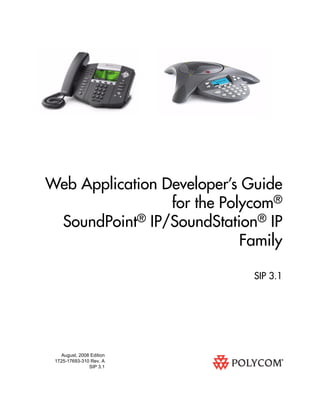
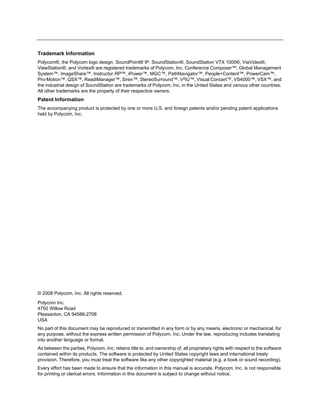
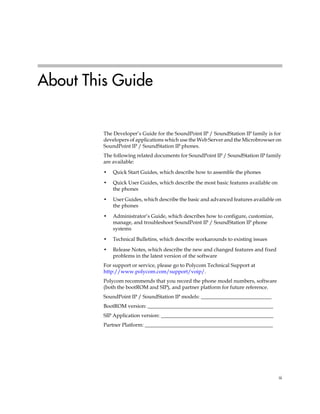
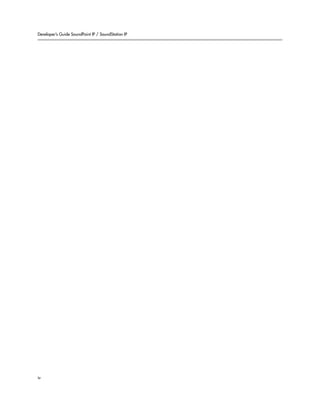
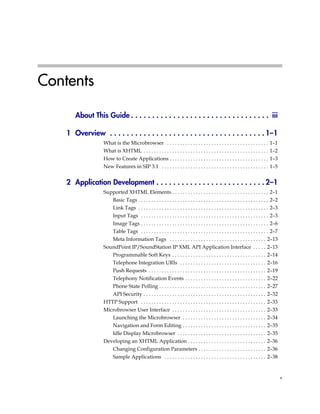
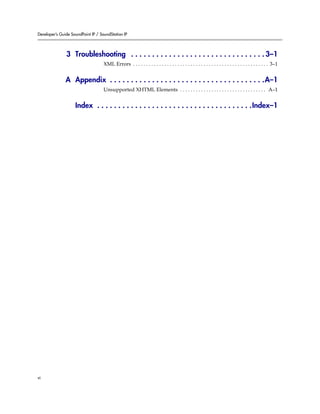

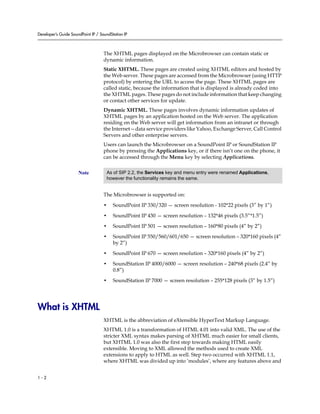
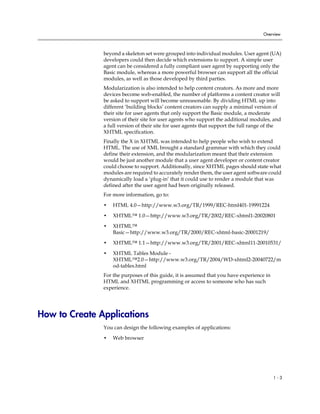
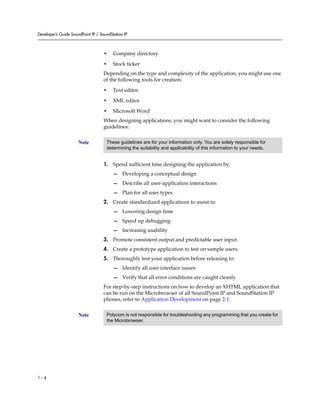
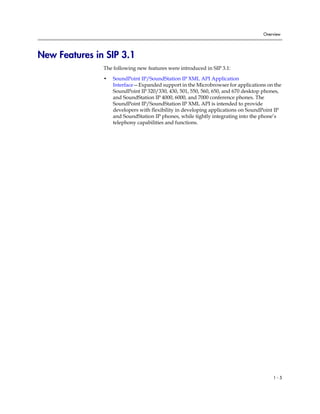
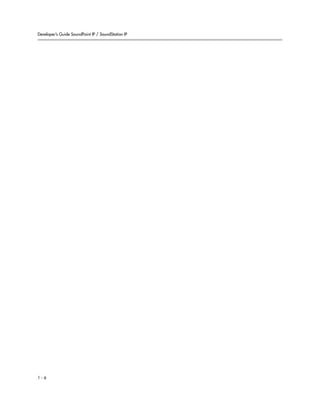
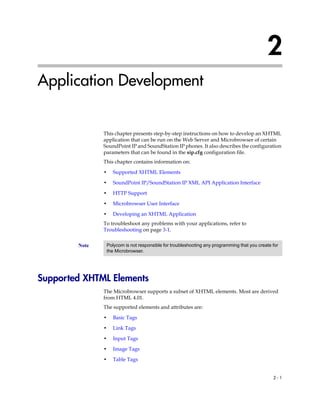
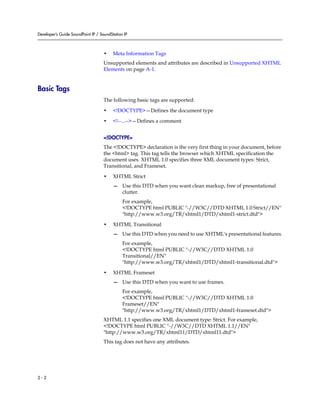
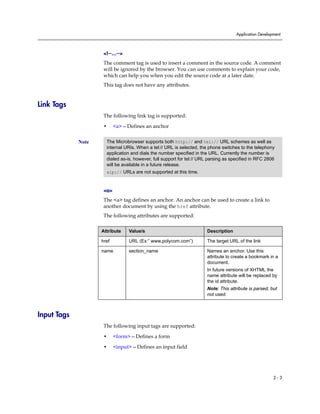
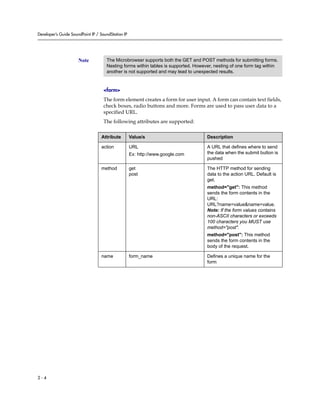
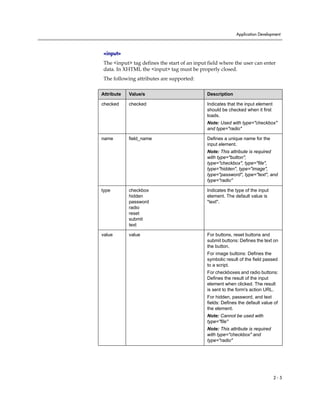
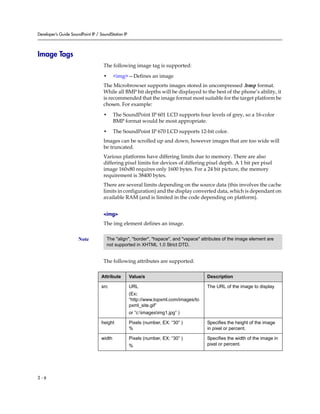
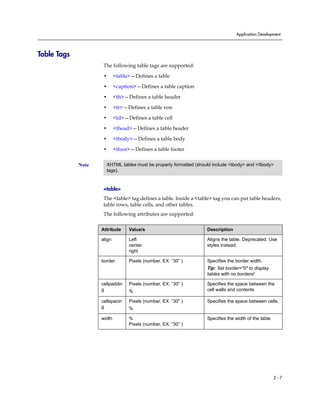
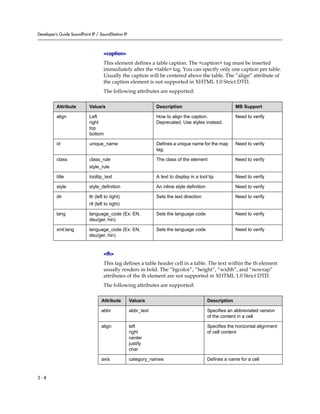


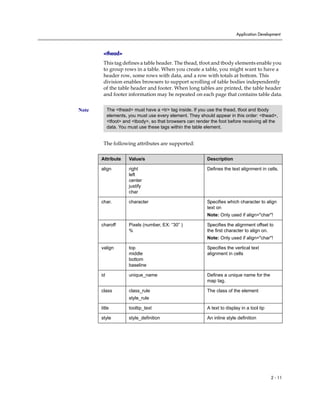
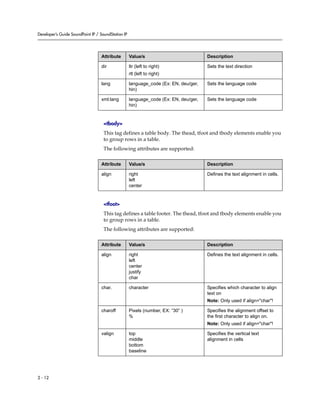

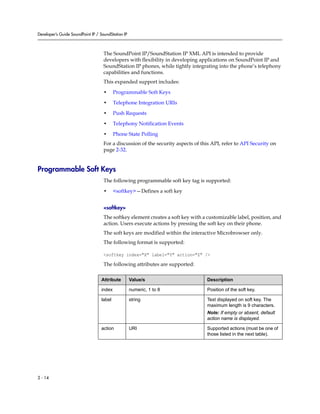
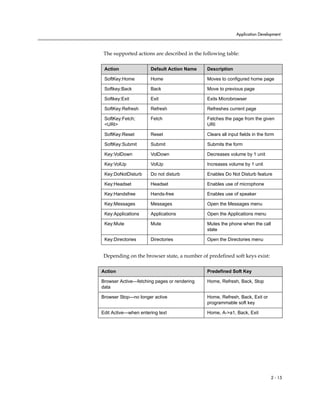
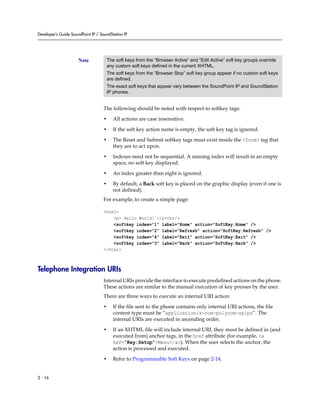

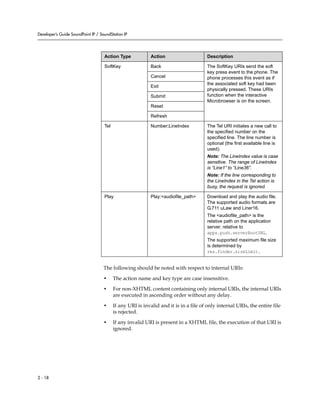

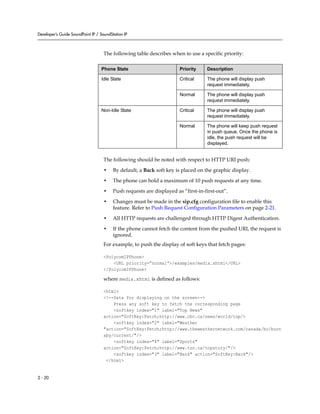
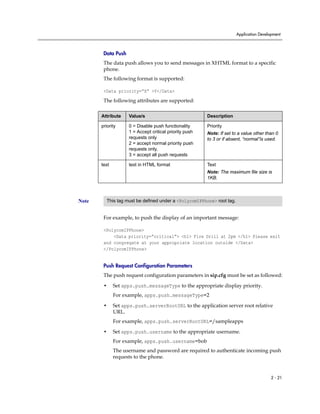
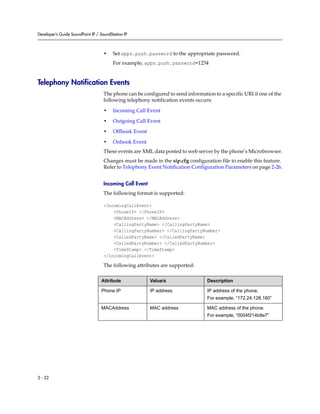


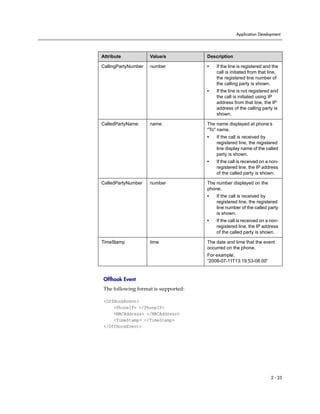
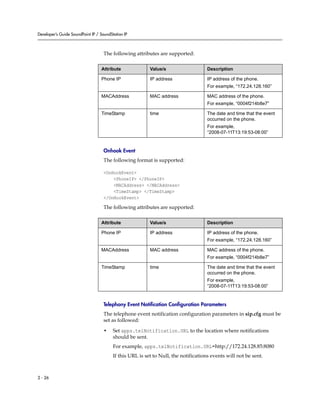
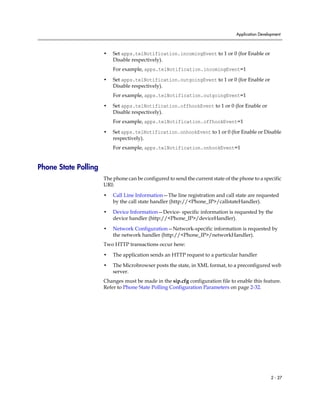
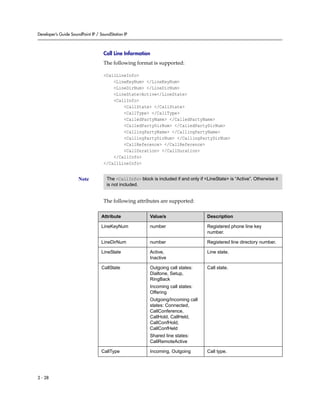

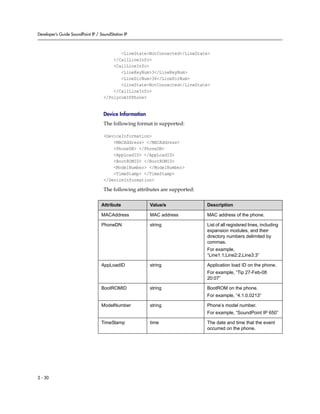
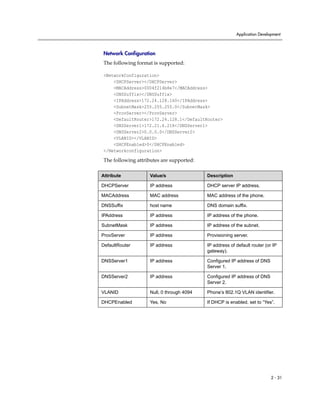
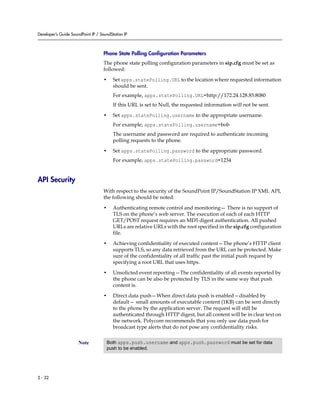
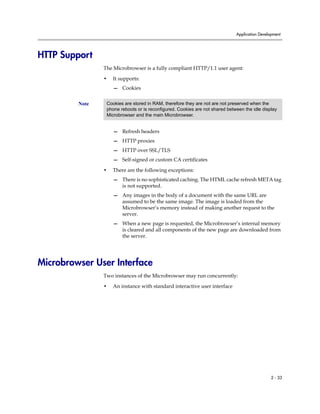
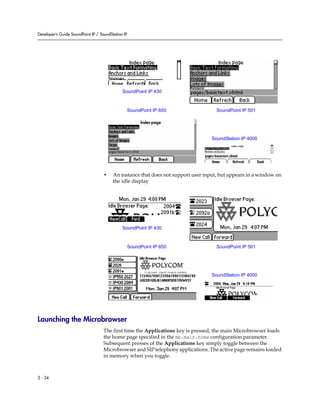

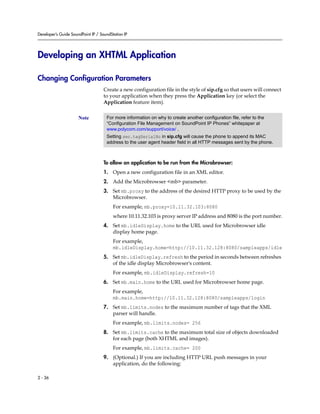

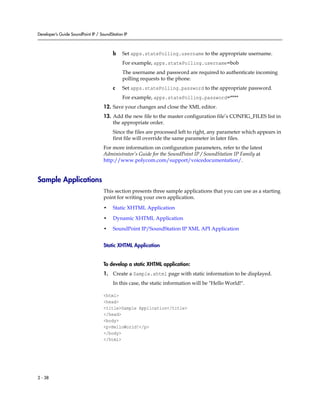
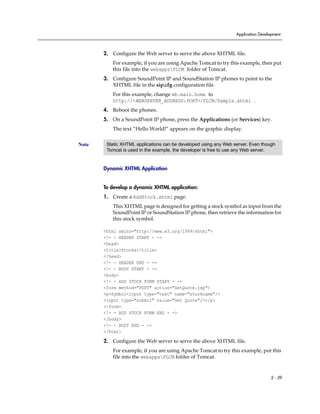
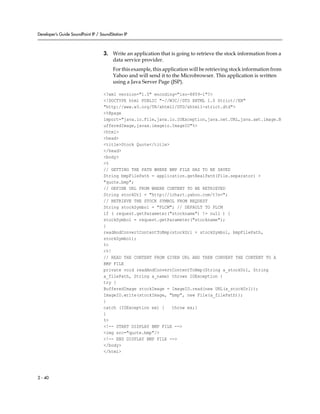
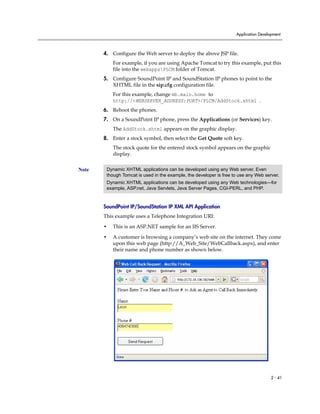
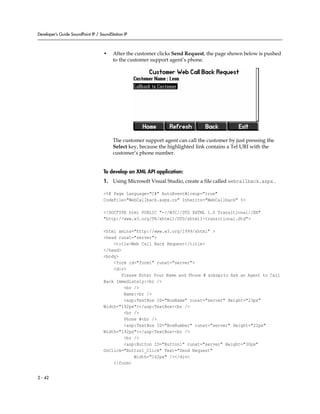
![Application Development
</body>
</html>
2. Using Microsoft Visual Studio, create a file called webcallback.aspx.cs.
using System;
using System.IO;
using System.Text;
using System.Data;
using System.Configuration;
using System.Net;
using System.Web;
using System.Web.Security;
using System.Web.UI;
using System.Web.UI.WebControls;
using System.Web.UI.WebControls.WebParts;
using System.Web.UI.HtmlControls;
using System.Threading;
public partial class WebCallback : System.Web.UI.Page
{
public static ManualResetEvent allDone = new
ManualResetEvent(false);
protected void Page_Load(object sender, EventArgs e)
{
}
protected void Button1_Click(object sender, EventArgs e)
{
String phoneNum = BoxNumber.Text ;
String name = BoxName.Text;
//send a push request to the phone with the IP address
callbackReq("172.18.103.32", phoneNum, name);
}
private void callbackReq(String phoneIP, String phoneNum, String
name)
{
String strLoc = "http://" + phoneIP + "/push";
String[] cred = { "Polycom", "456" };
NetworkCredential myCred = new NetworkCredential(cred[0],
cred[1]);
CredentialCache myCache = new CredentialCache();
myCache.Add(new Uri(strLoc), "Digest", myCred);
2 - 43](https://image.slidesharecdn.com/webapplicationdevelopersguidesip31-110612144901-phpapp01/85/Web-application-developers_guide_sip_polycom-55-320.jpg)
![Developer’s Guide SoundPoint IP / SoundStation IP
string result = "";
// Create the web request
HttpWebRequest request =
(HttpWebRequest)WebRequest.Create(strLoc);
WebRequestState myRequestState = new WebRequestState();
myRequestState.request = request;
request.Method = "POST";
request.Credentials = myCache;
myRequestState.createPostData(phoneNum, name);
IAsyncResult r = (IAsyncResult)request.BeginGetRequestStream(
new AsyncCallback(ReadCallback), myRequestState);
allDone.WaitOne();
// Get response
HttpWebResponse response =
(HttpWebResponse)request.GetResponse();
// Get the response stream
StreamReader reader = new
StreamReader(response.GetResponseStream());
// Read the whole contents and return as a string
result = reader.ReadToEnd();
reader.Close();
response.Close();
}
private static void ReadCallback(IAsyncResult asynchronousResult)
{
WebRequestState myRequestState =
(WebRequestState)asynchronousResult.AsyncState;
WebRequest myWebRequest = myRequestState.request;
// End the Asynchronus request.
Stream streamResponse =
myWebRequest.EndGetRequestStream(asynchronousResult);
byte[] byteArray =
Encoding.UTF8.GetBytes(myRequestState.getPostData());
2 - 44](https://image.slidesharecdn.com/webapplicationdevelopersguidesip31-110612144901-phpapp01/85/Web-application-developers_guide_sip_polycom-56-320.jpg)
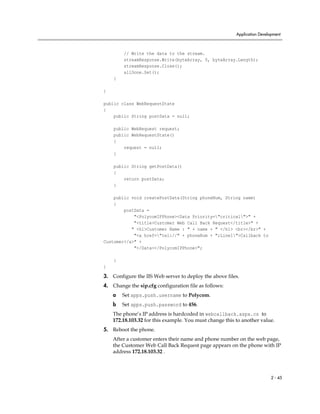

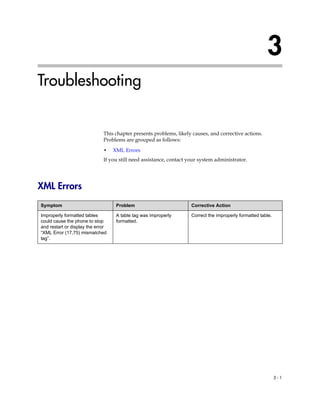


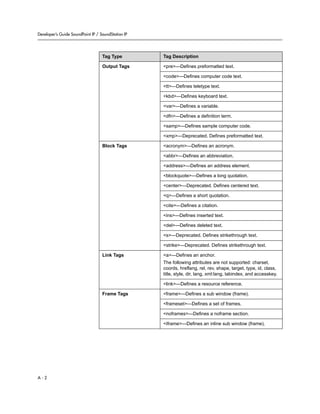
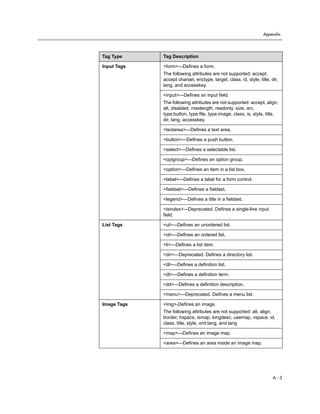
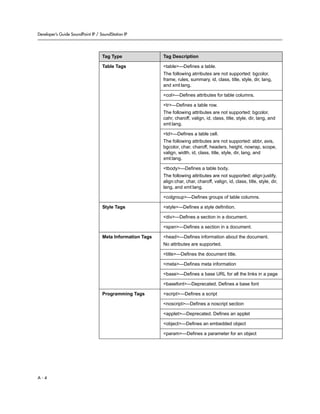
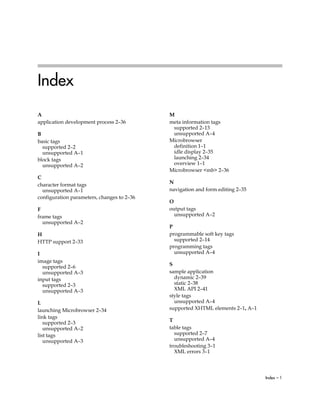

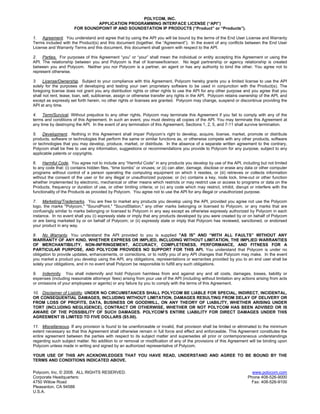

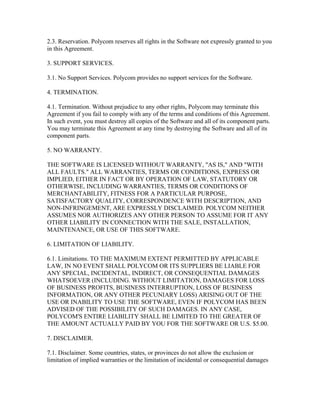

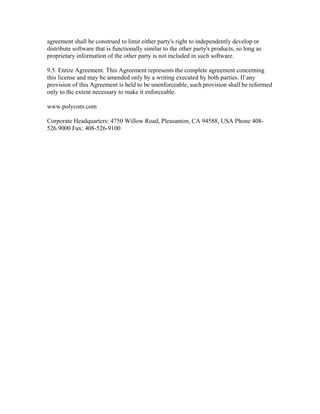

![I2 c from phillips[1]](https://cdn.slidesharecdn.com/ss_thumbnails/i2cfromphillips1-110505213842-phpapp02-thumbnail.jpg?width=560&fit=bounds)



























![2711e um006 -en-p[1]](https://cdn.slidesharecdn.com/ss_thumbnails/2711e-um006-en-p1-120514065850-phpapp02-thumbnail.jpg?width=560&fit=bounds)















